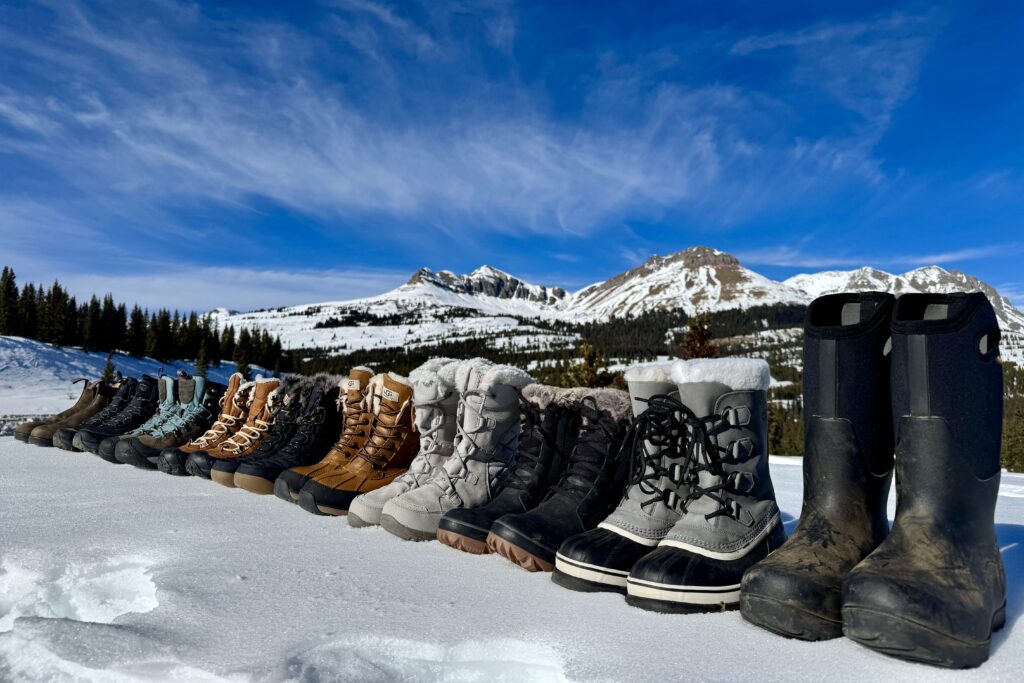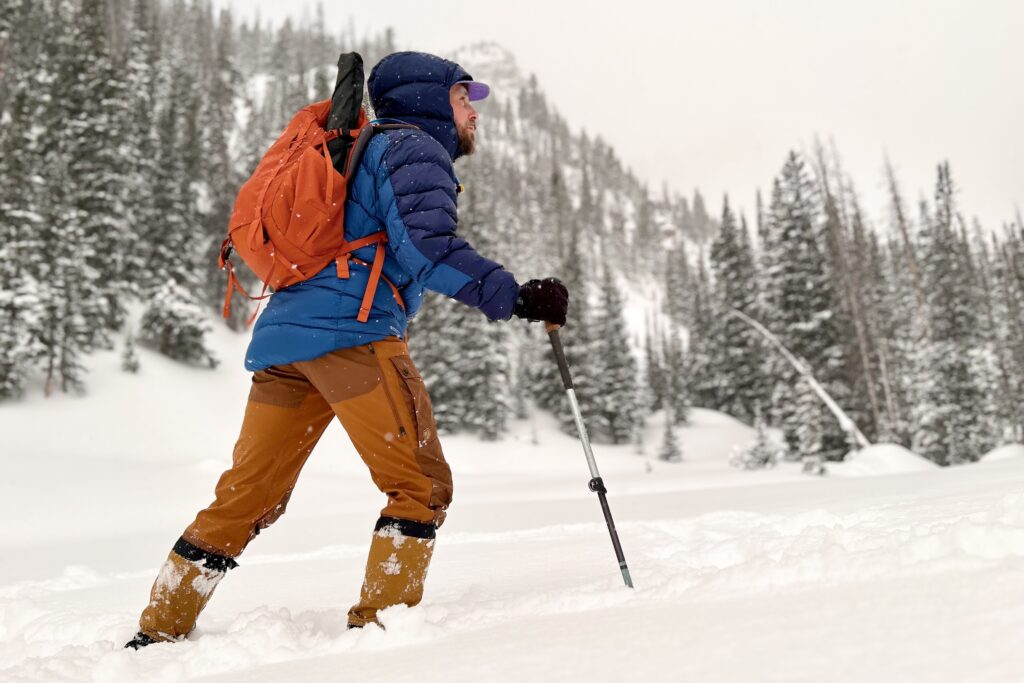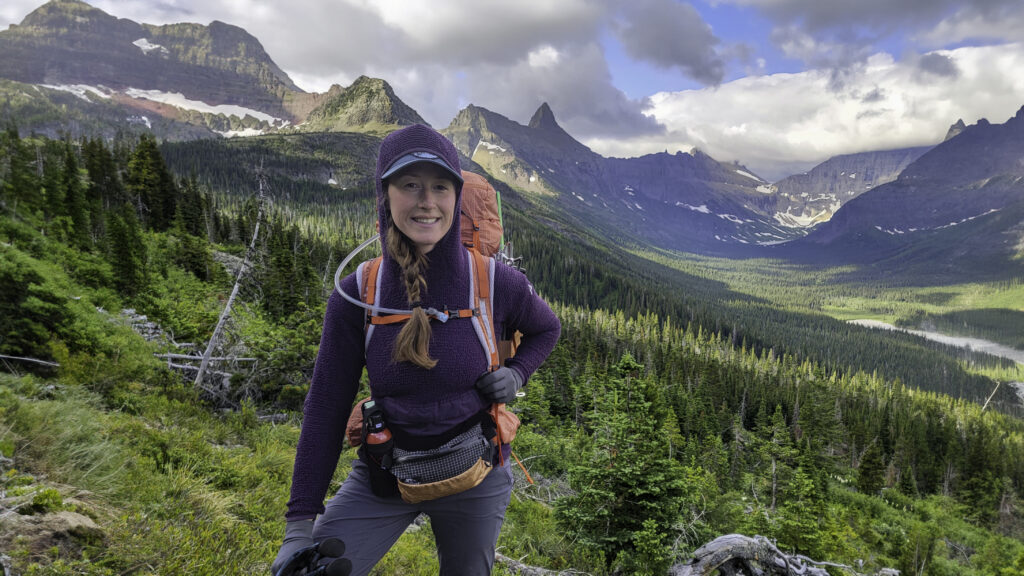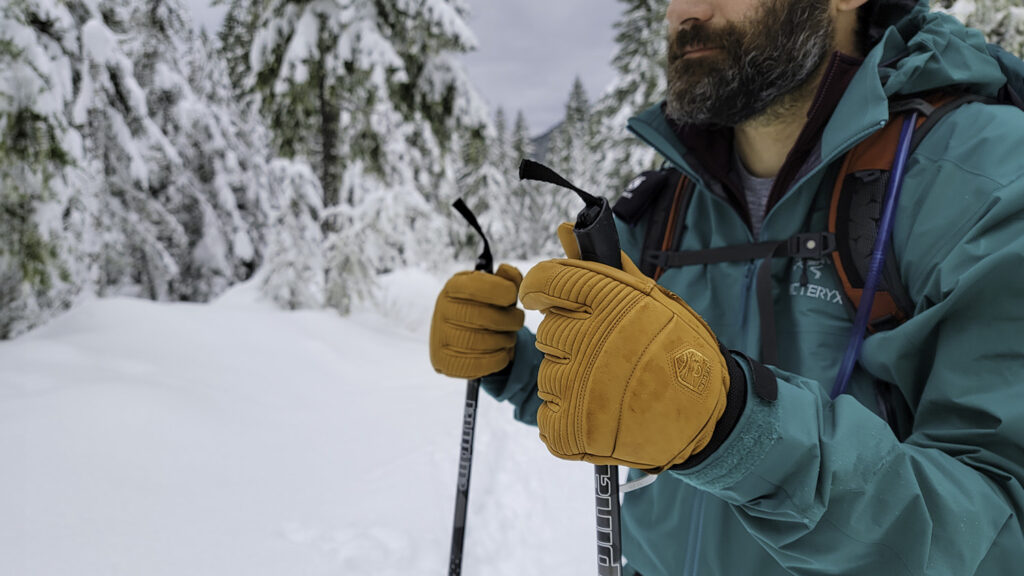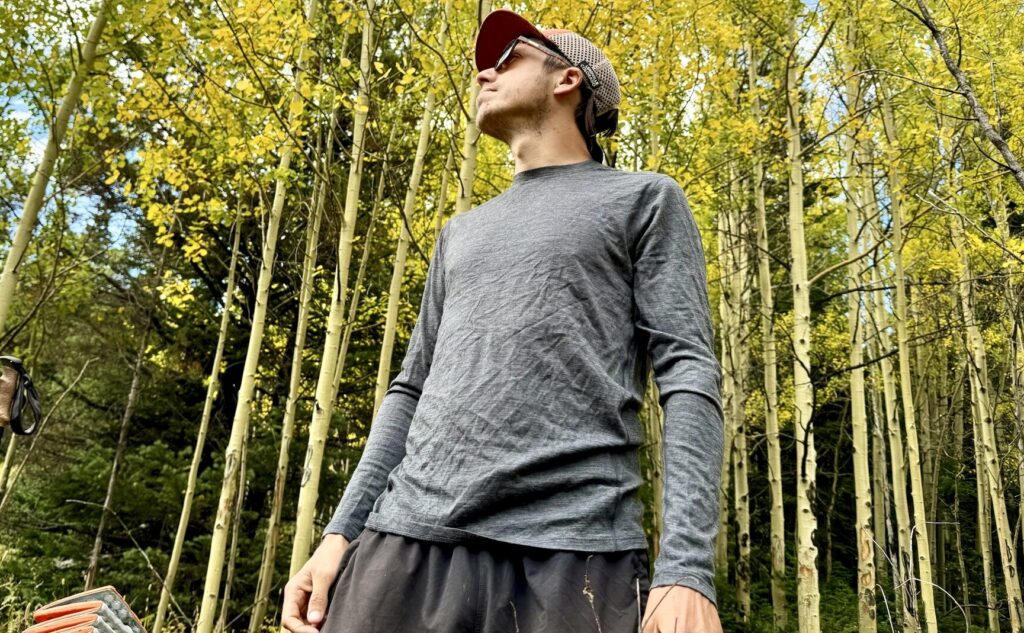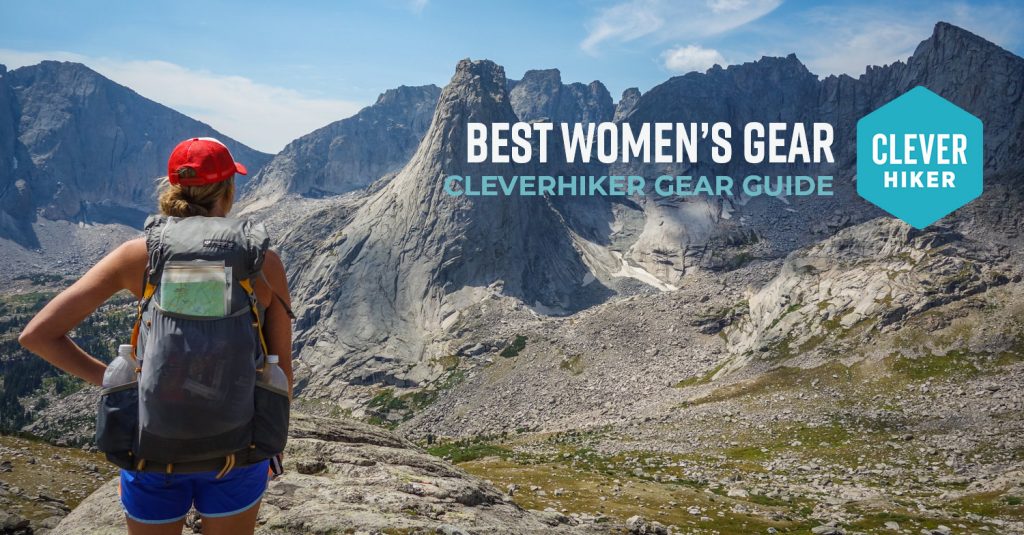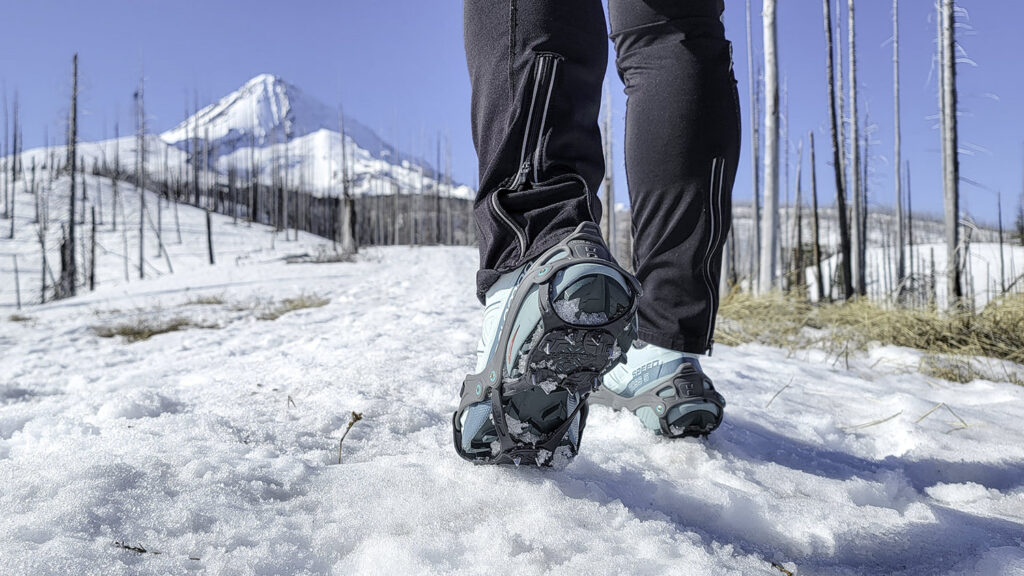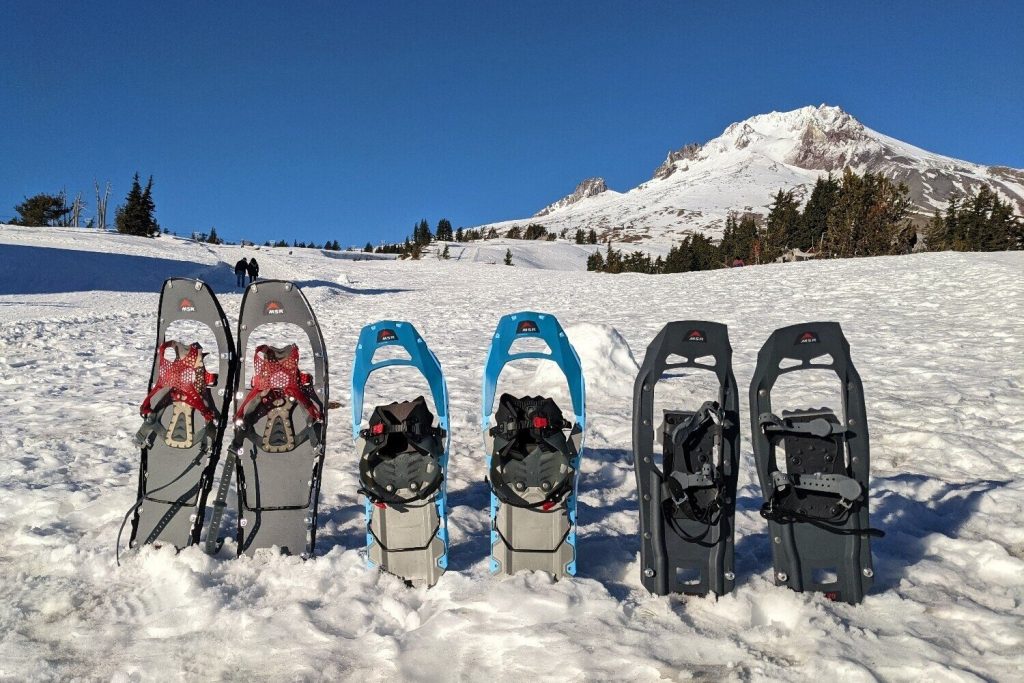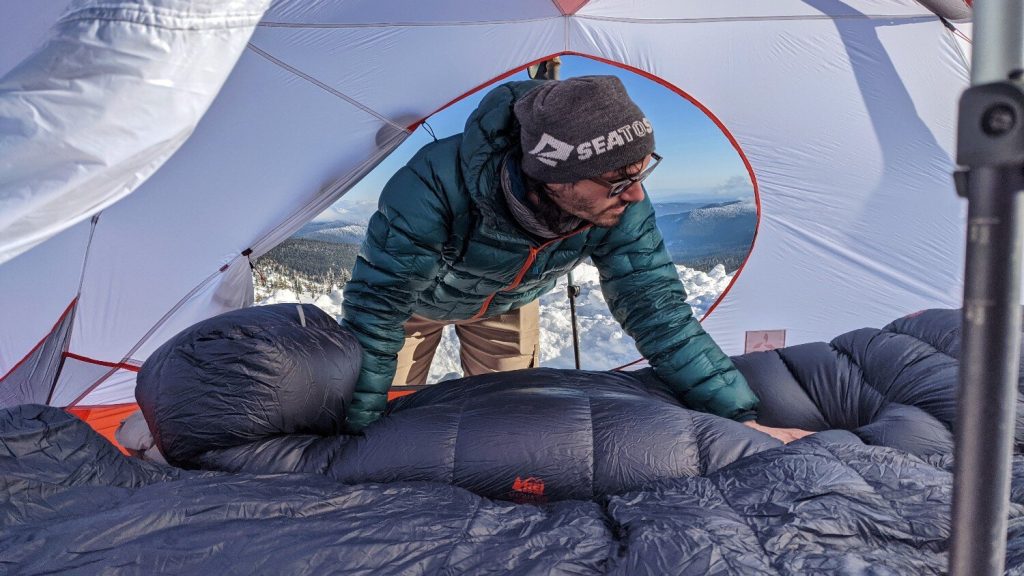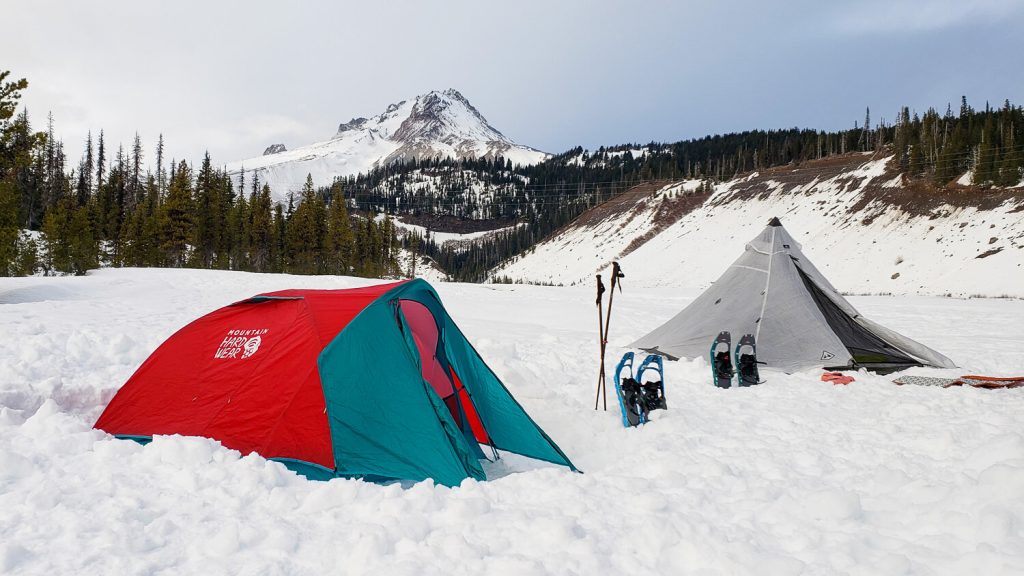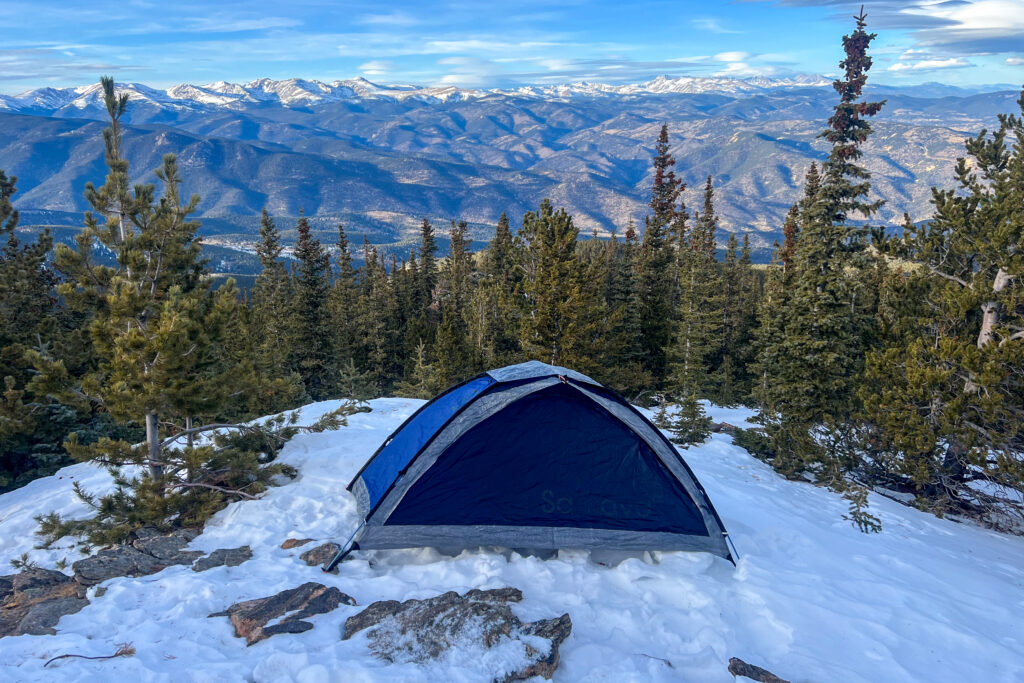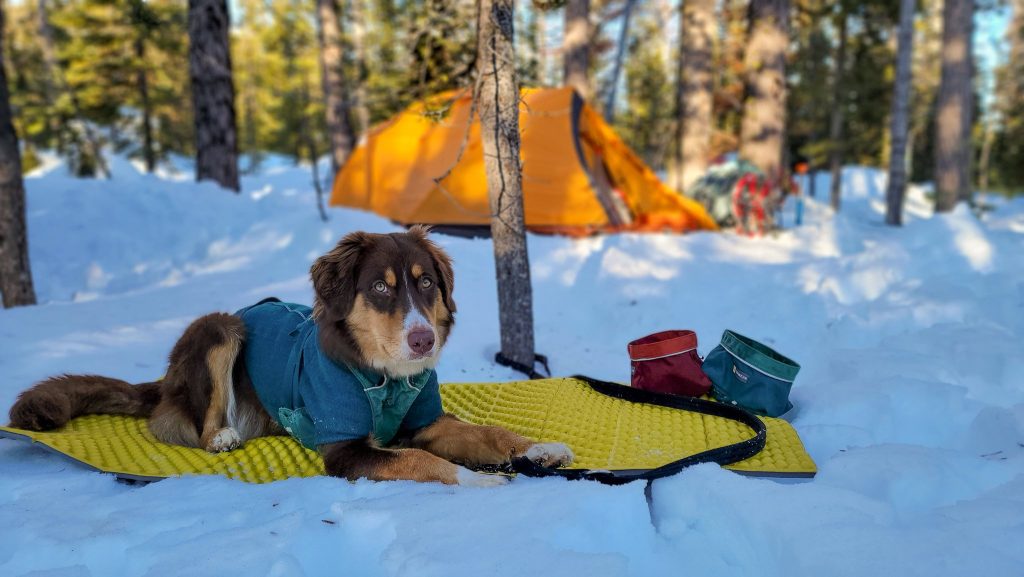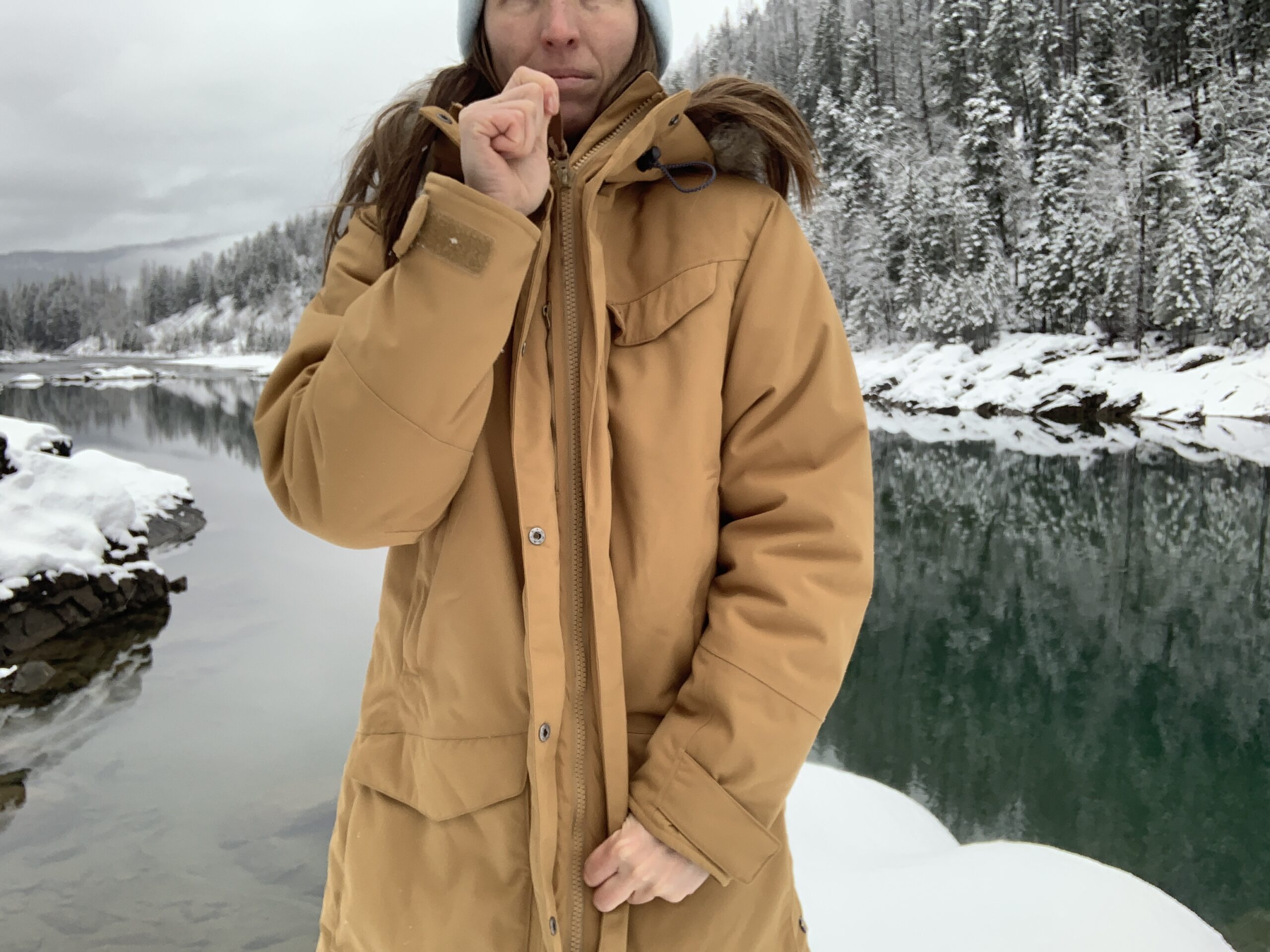
Looking for a winter coat that’ll keep you warm and toasty on the inside while winter rages on the outside? These winter jackets are for you.
Our team of gear analysts has rigorously researched dozens of winter jacakets and field-tested the 10 most promising coats to determine which will keep you happy while walking head-first into a storm.
These winter jackets aren’t technical backpacking gear, but they’re the ones you want when heading out for a walk, watching a game on some heat-sucking bleachers, running errands, or standing outside waiting for your kid to get dropped off. We looked at warmth, weather resistance, comfort, and features from brands like The North Face, REI, Outdoor Research, Fjallraven and more to create this guide of the best options out there.
And for more info, check out some of our other most popular gear guides:
Quick Picks for Women’s Winter Coats
Check out this quick list of our favorites if you’re in a hurry, or continue scrolling to see our full list of the best winter coats for women with in-depth reviews.
Best Winter Coat Overall: REI Stormhenge 850 Hybrid Down Parka ($279)
Best Waterproof Winter Jacket: The North Face Arctic Parka ($350)
Best Warm but not Bulky Down Parka: Rab Deep Cover Parka ($315)
Best Parka for Frigid, Windy Conditions: Outdoor Research Coze Down Parka ($399)
Best Synthetic Winter Jacket: Fjallraven Nuuk Parka ($500)
Ultimate Warmth & Coverage Parka: The North Face Triple C Down Parka ($350)
Best Winter Parka made with Sustainable Materials: Patagonia Down With It ($330)
Best Warm and Affordable Winter Jacket: REI Norseland Down Parka ($230)
Lightweight & Packable Down Coat for Mild Winters: LL Bean Ultrawarm ($250)
Best Budget Jacket for Mild Winters: Columbia Heavenly Long Hooded ($160)
What’s new
After another round of testing, we have made plenty of updates to the list:
- The REI Stormhenge remains our top pick due to its versatility, low bulk, and approachable price.
- Rab took its technical expertise on warmth, durability, mobility, and weather resistance and designed the street-savvy Deep Cover for when mountain conditions are at your doorstep.
- With its over-the-knee length, brushed water-resistant outer shell, oversized collar and draft tube, the Outdoor Research Coze Down Parka is, just as the name suggests, a cozy down that protects hard-earned body heat when old man winter howls.
- Built by a company that is no stranger to extreme weather, The North Face Triple C Down Parka is as close to being able to walk around in a zero-degree sleeping bag. It is our longest winter coat on the list, covering your calves.
- If you’re looking for one of the most heavily featured and engineered jackets on the market, check out the Fjallraven Nuuk Parka.
Women’s Winter Jackets Overall Testing Scores
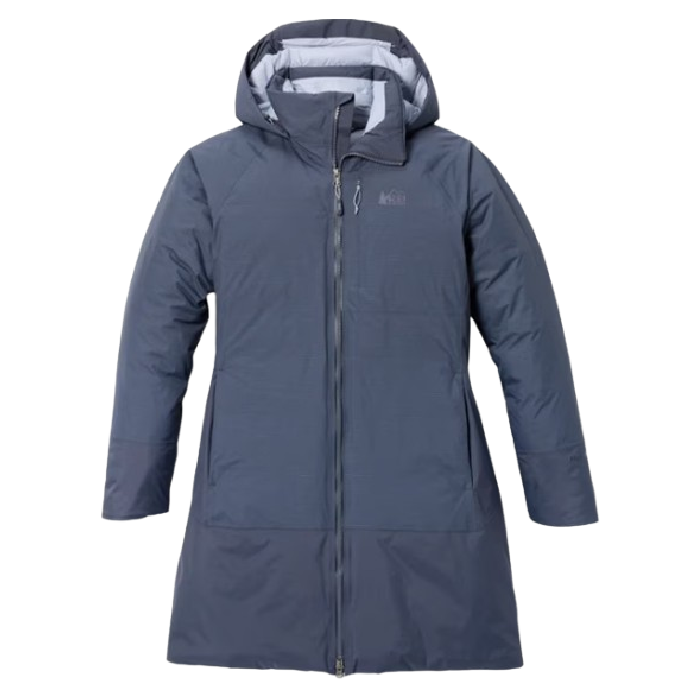
REI Stormhenge 850 Down Hybrid Parka
Best Winter Coat Overall
CleverHiker Rating: 4.8/5.0
Price: $299
Weight: 1 lb. 10.5 oz.
Insulation: 850-fill-power down / synthetic blend
Length: 36.5 in.
Pros
- Comfortable
- Waterproof
- Versatile
- Lightweight & compressible
- Flattering fit
- Body-mapped insulation
Cons
- Size up for broader chest/larger or long arms
- Wrist gaskets don't have thumbholes
- Zipper is a little stiff
This is our lightest winter coat, but that doesn’t make it a fair-weather friend. This is the “we can weather the weather, whatever the weather” parka. The women’s REI Stormhenge Hybrid Parka is the parka length of their best-selling waterproof and insulated Stormhenge 850 Down Hybrid jacket.
This winter coat falls just above the knees and effortlessly blends warmth, weather protection, and practicality. We love this winter coat because it is functional for low to moderate winter adventures where you might build a sweat but then quickly get to a resting rate. It also doesn’t look so techy that it can’t work as everyday outdoor wear.
Featuring an 850-fill-power down body and synthetic insulation in the hood and side panels where your body dumps moisture and excess heat, it provides an excellent warmth-to-weight ratio while staying effective in wet conditions. The HydroWall 2L waterproof shell, paired with DWR-treated insulation, keeps you dry, while thoughtful touches like a brimmed hood and wrist gaskets keep the snow and rain from getting to your mid or base layers.
The Stormhenge performed in temperatures as low as 10°F, but only if we weren’t standing still to generate more internal heat for the down to hold.
Its above-the-knee length cut gives you full seat coverage for sitting on bleachers, benches, or snow. Because it is above the knee, there isn’t any restriction of leg movements unless you’re lunging. For a waterproof down jacket, it still wears like a lightweight puffer and is easy to pack. It pairs well with a base and mid-layer, but chunky sweaters and high-pile fleeces will feel like a little much.
Delightful features include buttery soft tricot-lined hand pockets, a roomy external chest pocket, deep internal drop pockets, an adjustable hem, and fully sealed seams. Altogether, this jacket is the whole kit and caboodle.
We had a hard time coming up with complaints (maybe the internal lining is so soft it could rip easily?) We have no proof or read any reviews of this being an issue. Tested in Montana’s sleet, hail, snow, and 40 mph winds, this jacket proved itself durable and adaptable in a variety of winter conditions.
More: Women’s REI Stormhenge 850 Down Hybrid Parka Full Review
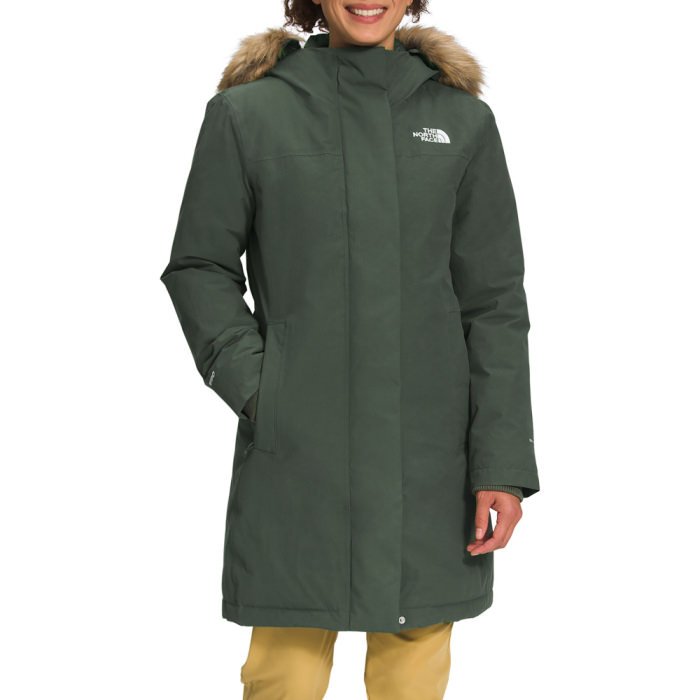
The North Face Arctic Parka
Best Warm & Waterproof Winter Parka
CleverHiker Rating: 4.8/5.0
Price: $350
Weight: 2 lb. 13.5 oz.
Insulation: 600 fill-power down
Length: 35.25 in.
Pros
- Waterproof
- Highly protective hood with removable faux-fur ruff
- Warm
- Breathable
- Flattering fit
- Durable construction
- Comes in lots of colors
Cons
- Heavy
- Not the most packable
- Pockets aren't insulated
- Less insulated in the arms
The North Face Arctic Parka is a life-long winter jacket that blends solid comfort, durability, and performance with sleek street-ready style. We also appreciate the price, because we’d expect this coat to cost more for how versatile it is.
With 600-fill-power recycled down insulation and a weatherproof 2-layer DryVent shell, this parka keeps you warm and dry in cold, wet conditions. Think wintery mixes, coastal bone-chilling freezing fog, and playing with kids in the snow. It offers excellent coverage with its mid-thigh length, and the removable faux-fur-lined hood brings extra warmth and a cozy feel on windy days.
It’s not the lightest or most packable jacket in its class, so if you’re going on a trip, get a big duffle. The down insulation holds its own in temperatures down to around 0°F so long as you’re moving and wearing the right layers. Thoughtful details like zippered hand pockets, an adjustable waist, and a roomy interior make it an easy choice for those who value function and warmth.
If you need a dependable, full-coverage winter coat that handles everything from city streets to snowy trails, the North Face Arctic Parka is a solid pick. It’s not built for extreme alpine conditions, but it’s a great everyday jacket that balances warmth, weather protection, and comfort at a great value.
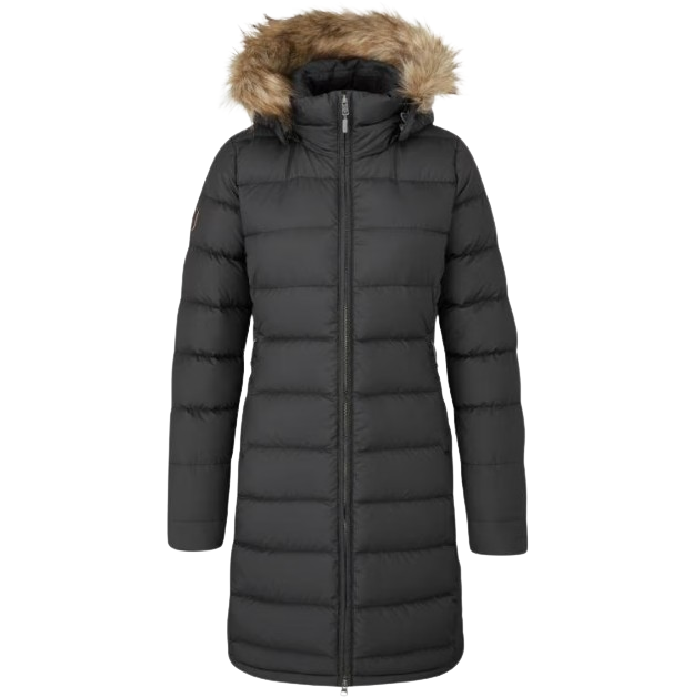
Rab Deep Cover Down Parka
Best Warm but not Bulky Down Parka
CleverHiker Rating: 4.7/5.0
Price: $315
Weight: 1 lb. 13.1 oz.
Insulation: 700 fill-power down
Length: 35.4 in.
Pros
- Warm
- Comfortable
- Tailored fit
- Quick-drying
- Down treated with Nikwax
- Lightweight & packable
- Removable hood
- Removable faux fur ruff
Cons
- Not as durable as some
- No fleece on the collar
- Limited room for layering
The Rab Deep Cover Parka was the coat we kept coming back to when we knew it would be wintery, but we wanted to feel a little feminine and like we weren’t wearing a down comforter.
Packed with 700-fill-power hydrophobic goose down and treated with Nikwax, this jacket is toasty and resists moisture, which is key for down to function optimally. Rab notes that the 700-fill power weighs 12 oz, which means they didn’t skimp on stuffing this jacket with insulation. For this reason, the Deep Cover excels in extreme cold conditions without adding unnecessary bulk and is ideal for wintery walks.
The DWR finish protects against light snow and brief exposure to rain. We wouldn’t put this coat on if we knew precipitation was in the forecast, especially heavy, wet snow or prolonged rain. However, it dries quickly and retains its loft even if it does get a little wet.
Its chevron baffles on the side panels make the fit feel contoured to your body and don’t add bulk under your arms. The construction didn’t leave vulnerable cold spots, and from the thigh to the crown of our head, it felt cozy and warm. It was the Goldilocks of parka jackets, not too hot and not too cold.
Rab is known for high performance, no-nonsense, and never selling a trend. They included long, stretchy lined cuffs on this jacket that keep snow and drafts out. The front of the pockets are fleece for added comfort. The zipper is buttery and brass-colored metal, which rounds out this highly functional jacket with a little nod to high-quality streetwear.
The parka’s fitted cut acknowledges that this layer is about getting from A to B without losing your core temperature and without overheating. If you wanted to layer, we would suggest low-bulk, high-performing mid and base layers because of the slimmer fit.
Lightweight and packable, it compresses easily into about the size of a basketball (smaller if you use a compression sack), making it a reliable choice for traveling to cold-weather destinations. The Rab Deep cover is a worthy investment for its urban versatility, lightweight wearability, and just-right warmth for walking in temperatures that drop into the single digits.

Outdoor Research Coze Down Parka
Best Parka for Frigid, Windy Conditions
CleverHiker Rating: 4.7/5.0
Price: $399
Weight: 2 lb. 3 oz.
Insulation: 95% 700+ fill-power down / 5% synthetic
Length: 43 in.
Pros
- Super warm
- Durable
- Calf long-length coverage
- Wind/water resistant
- Tall collar with soft chinguard
- Draft tube
Cons
- Expensive
- Shell attracts hair/lint
- Bulky for casual use
The Outdoor Research Coze Parka is built for standing around in extreme cold. Its warmth comes from combining 700-fill down insulation with a rugged 100% Recycled Nylon 70D X 90D Plainweave shell. Its knee-length and exceptional wind resistance make it a reliable choice for those venturing out into utterly cold and windy outings. Run cold? Sitting on a bleacher? Waiting for the bus? Walking the dog in 40 mph winds? Like an oversized fit? This one’s for you.
This parka wraps you up like a cozy sleeping bag. It has excellent insulation thanks to its 700-fill down, insulated draft neck tube baffle, soft cuffs with a thumb hole, oversized collar(longest in our list), and down baffle-ruff hood.
The weather resistance is solid, with a wind/water resistant shell that keeps you dry in light rain and snow, though it’s best suited for dry, frigid climates.
The Coze shines in comfort, with a generous cut that tapers to the side zips. This maximizes warmth and protection when you’re stationary, but side zips can be used to give you more mobility and comfort as needed. For being such a large parka, it still has a lightweight feel that lets you move freely without feeling weighed down. It’s soft, cozy, and incredibly easy to wear.
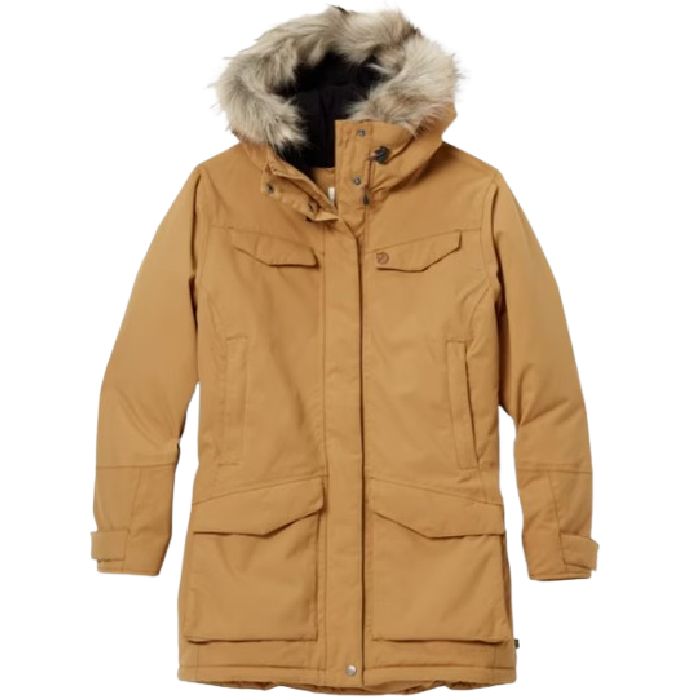
Fjallraven Nuuk Parka
Best Synthetic Winter Jacket
CleverHiker Rating: 4.7/5.0
Price: $500
Weight: 3 lb. 13.1 oz.
Insulation: Synthetic: 250g Supreme Microloft polyester
Length: 33.8 in.
Pros
- Warm
- Durable
- Lots of fleece lined pockets
- Extreme weather face coverage
- Oversized for layering
- 11 pockets
Cons
- Heavy/bulky
- Runs large
- Shell doesn't shed moisture well
- No wrist gaskets
- 11 pockets
The Fjällräven Nuuk Parka is full-on in every sense of the sentiment. It has a workwear-inspired heavy-duty woven shell that refuses to let weather soak in or get torn up by branches or rocks.
This coat is made for those heading outside into harsh winter conditions for extended periods. Don’t be deterred by the lack of down feathers. Its synthetic Microloft insulation and durable polyamide shell deliver reliable warmth, even in wet weather. With waterproof and windproof capabilities, it’s perfect for winter work, ice fishing, dog sledding, walking in a storm, outdoor adventures in places like Montana or British Columbia, or simply navigating an urban concrete jungle.
The Nuuk is relentless with its design and construction with its long length and robust materials, providing solid protection against wind and snow. However, the loose fit at the hem may let some cold air sneak in, and its weight makes it best suited for stationary or low-intensity activities rather than high-energy backcountry pursuits (unless it’s record low temps). We quickly had to unzip the coat on a slight hill walk mid-winter.
With 11 pockets, a fleece-lined collar and hood, a removable faux fur ruff, and oversized leather zipper pulls, the Nuuk offers ample storage and glove-friendly convenience. However, the jacket’s larger, boxy fit might feel too roomy for some, so consider sizing down.
If you’re looking for a jacket that prioritizes warmth, durability, and versatile storage, the Nuuk is a great choice. While it may not appeal to minimalist adventurers or anyone trying to pack this coat into a suitcase, it’s perfect for those needing a rugged, high-performance jacket for frigid conditions or tough winter tasks.
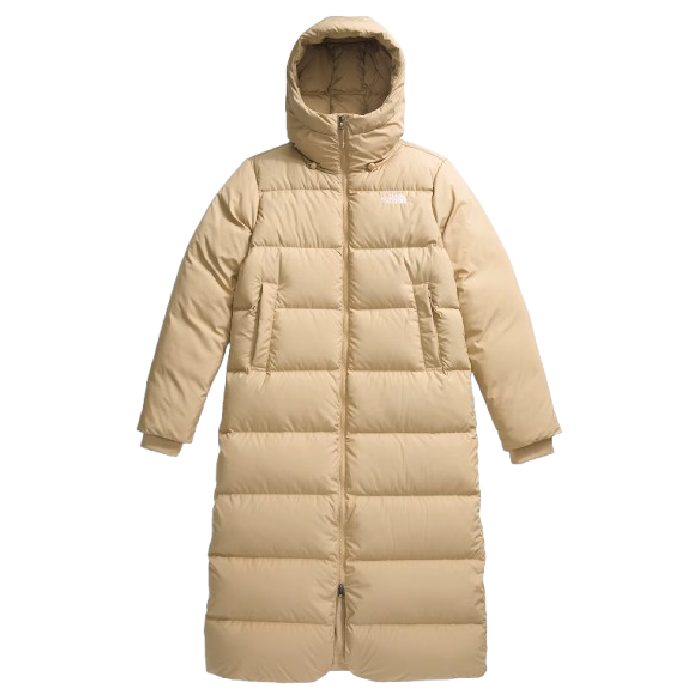
The North Face Triple C Parka
Ultimate Warmth and Coverage Parka
CleverHiker Rating: 4.6/5.0
Price: $350
Weight: n/a
Insulation: 600 fill-power down
Length: 46.4 in.
Pros
- Premium quality
- Smooth zipper
- Super warm
- Ultimate coverage
- Non-PFC DWR Finish
Cons
- Expensive
- Bulky for casual use
The North Face Triple C Parka is your ultimate maximum coverage against extreme cold weather. With its long, mid-calf cut and high-loft down insulation in oversized baffles, the coat provides serious warmth and coverage for those brutally cold days to keep you toasty while standing around, walking the dog, or running errands in freezing temperatures. Tested in sub-zero conditions, it’s built for serious cold conditions.
This parka’s large, insulated hood, soft nylon lining, and gaiter cuffs ensure that no cold spots sneak in. While it’s not the most versatile or everyday option, its warmth and comfort make it perfect for those who face harsh winters head-on. We also immediately noticed how easy it was to zipper the exposed two-way zip. This is a great zipper for folks who tend to lose dexterity when out in the cold. The zipper is backed with an internal storm flap to keep your warmth in and the cold out.
If you’re looking for a reliable, everyday winter coat that can handle freezing temperatures and provide cozy protection in snowstorms, the Triple C Parka is a solid choice. Our only complaint is that because it is so long, we often got the bottom of the jacket dirty by brushing it against the car when getting in and out.
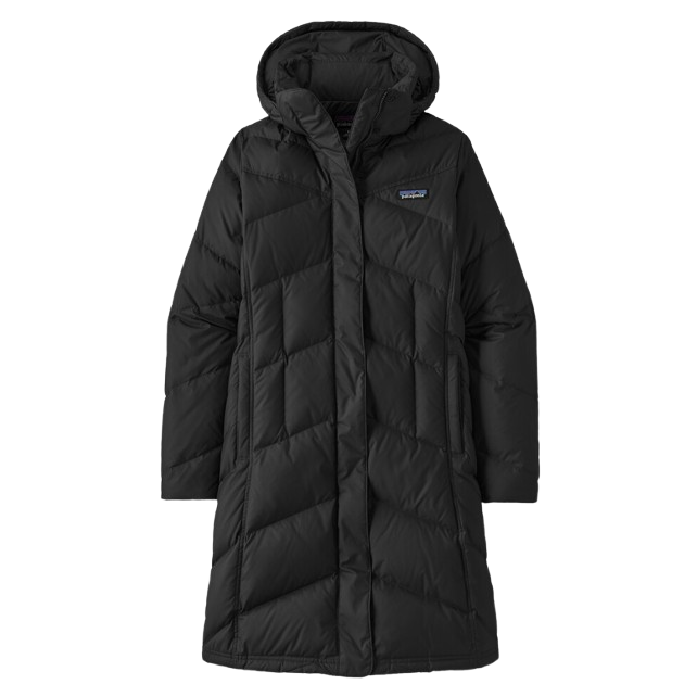
Patagonia Down With It Parka
Best Winter Parka Made With Sustainable Materials
CleverHiker Rating: 4.5/5.0
Price: $350
Weight: 2 lb. 5 oz.
Insulation: 600 fill-power down
Length: 39.3 in.
Pros
- Exceptionally comfortable
- Great mobility
- Durable but soft outer fabric
- Stylish fit for a longer parka
- Unique baffle stitching
Cons
- Not good for wet snow/rain
- Stains/discolors easily
- Heavy
- No wrist gaskets
The Patagonia Down With It Parka combines 600-fill down insulation with a unique princess and chevron baffle stitching for a warm, flattering, easy-to-move-in knee-length winter coat. If you run cold, this is a great winter coat that doesn’t wear like a sleeping bag.
Designed for low-output and cold-weather outings, this parka provides excellent coverage, and the knee length doesn’t feel restrictive when you’re on the move.
In our insulation test, the 600-fill Down With It parka took 108 minutes to drop to ambient temperatures, which was impressive because it didn’t have the biggest baffles on our list. The weight and warmth of this coat will have you unzipping it to dump heat if you’re on a more strenuous walk.
If you’re trying to shop more ethically, this down is from reclaimed goose and duck products, and the shell and lining are 100% recycled polyester taffeta with a durable water-repellent (DWR) finish made without perfluorinated chemicals (PFCs/PFAS). The result is a superior constructed jacket that is still warm and cozy. This coat is meant to last a lifetime.
If you’re headed for a winter walk, the shell beads light rain and snow effectively, though soggy outings will wet through the lining relatively quickly. The down isn’t hydrophobic, so once this jacket soaks, it needs a full drying period to perform as intended. This winter coat doesn’t have gasket cuffs, so it isn’t the best for playing in the snow without gauntlet-style mittens/gloves.
One internal chest pocket and two ultra-soft waist pockets are handy for keeping your hands and gadgets warm. The hood can cinch for when you really need to keep the elements out. The hood is also removable with snaps, which made us slightly concerned about drafts making it through if you’re in gale-force winds, but they addressed that with an extra panel to cover the gap, so we never noticed it. The fleece-lined neck is also, ugh, so nice.
We had no worries relying on it for warmth in temperatures down to the teens and twenties, without exerting much energy to generate body heat. Its parka length and tailored design make it suitable for low-bulk layering in colder weather or as a stand-alone jacket in the fall and spring.
The fit runs a touch small, and though we could wear a knit sweater underneath, if you’re curvy or have broad shoulders, potentially sizing up will be the move.
This winter coat is a great blend of Patagonia’s sustainable designs with technical savvy on warmth, water-resistant fabrics, and timeless designs, making it a solid choice for most winter outdoor jaunts. The lighter colors will stain and darken, so follow Patagonia’s washing instructions or go with a darker color.
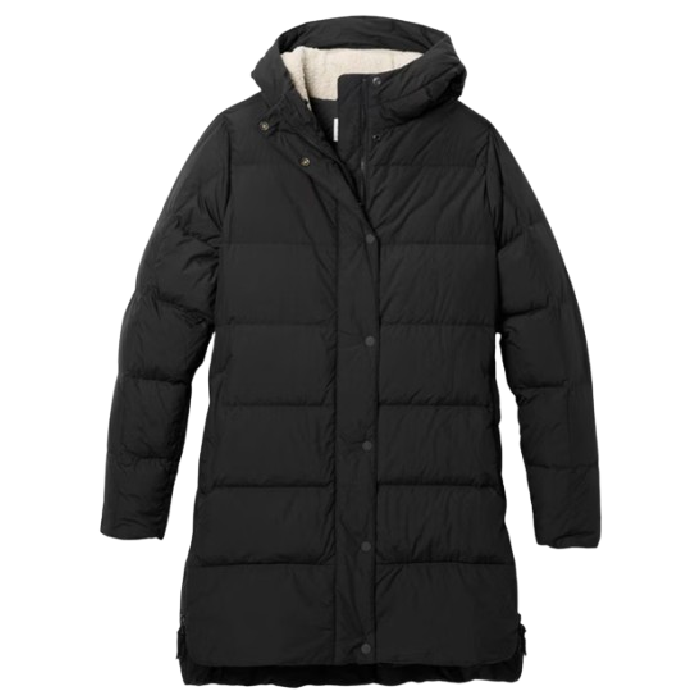
REI Norseland Parka
Best Warm and Affordable Winter Coat
CleverHiker Rating: 4.5/5.0
Price: $230
Weight: 2 lb. 2.2 oz.
Insulation: 650 fill-power down & 120g synthetic blend
Length: 36.5 in.
Pros
- Very warm
- Water-resistant
- Shearling hood
- Relaxed fit
Cons
- Side zips give it a boxy shape
- Need to be careful with snaps ripping fabric
- Slightly noisy fabric
The REI Norseland Down Parka strikes a fantastic balance between warmth, style, and affordability. With 650-fill down and 120g of synthetic insulation in key areas, it’s ready for cold days, and the PFA’s free DWR-coated shell offers light protection against precipitation.
With one of the lowest prices on our list of favorite winter parkas, you’re getting a quality coat that’s about 30% cheaper than comparable options. In our timed insulation test, the Norseland was a top performer. Plus, features like a fleece-lined hood, knit cuffs, and an inner and outer storm flap on the front zipper make it extra cozy for everyday winter wear.
The Norseland is boxier than some more tailored jackets, and the added side zips, while they add mobility and venting as needed, make the back of the jacket spread away from you. The hood cinches are also on the inside of the neck, which isn’t the most functional and, unfortunately, could sometimes feel while it was fully zipped.
If you’re looking for a casual winter jacket that doesn’t break the bank, the REI Norseland Down Parka delivers great value with all the features you need to stay warm in cold weather. It is a great buy for budget-conscious winter warriors.
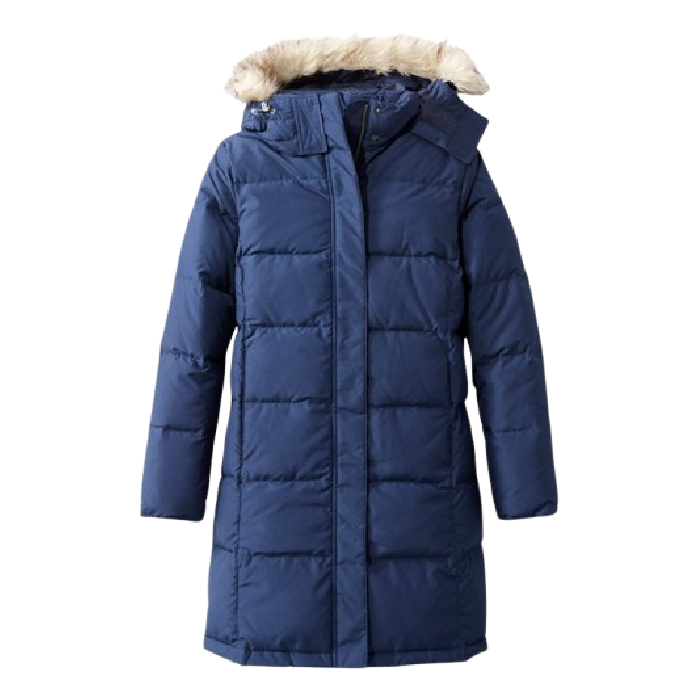
L.L. Bean Ultrawarm 3/4 Length Down Parka
Lightweight, & Packable Down Coat for Mild Winters
CleverHiker Rating: 4.3/5.0
Price: $250
Weight: 2 lb. 4.6 oz.
Insulation: 650 fill-power down
Length: 37 in.
Pros
- Packs down
- Removable hood and removable faux fur ruff
- Comfortable
- Affordable
- Effective hydrophobic down
- Lots of color and size options
Cons
- Inner lining can fold out at the hood and cuffs
- Velcro collar system isn't the most functional
- Not warm enough below 20 degrees
L.L. Bean Ultrawarm 3/4 Length Coat is your go-to coat for staying cozy when temperatures start to drop. Designed with 650-fill water-repellent down, this jacket offers moderate warmth without being bulky. If you live in a place with mild winters (hovers around freezing), this coat is sufficient, but we had to keep our pace up to stay warm below 20 degrees. Still, the relaxed fit made adding layers easy and helped extend this coat’s wearability into cooler temps.
The 3/4 length provides extra coverage, keeping your thighs warm, while the water-resistant shell and insulated hood protect you from snow and rain. Whether running errands or taking a winter walk, this coat’s thoughtful features—like the fleece-lined pockets and fleece cuffs—keep you comfortable and shielded from the cold.
We did find a few hangups. The velcro closure for the neck isn’t the most functional or comfortable. For example, if you aren’t using the velcro, it rests open on your lapel, and if you have long hair that falls in front of your shoulders, it might get mixed in with the velcro. We loved this coat best with the hood removed. There’s also a tiny inner velcro pocket that we didn’t find very useful, aside from hand warmers or chapstick.
If you’re looking for a warm, winter coat that’s both functional and lets you add bulky layers, the L.L. Bean Ultrawarm 3/4 Length Coat delivers, making it a great choice for everyday winter wear in moderate cold without costing you an arm and a leg.
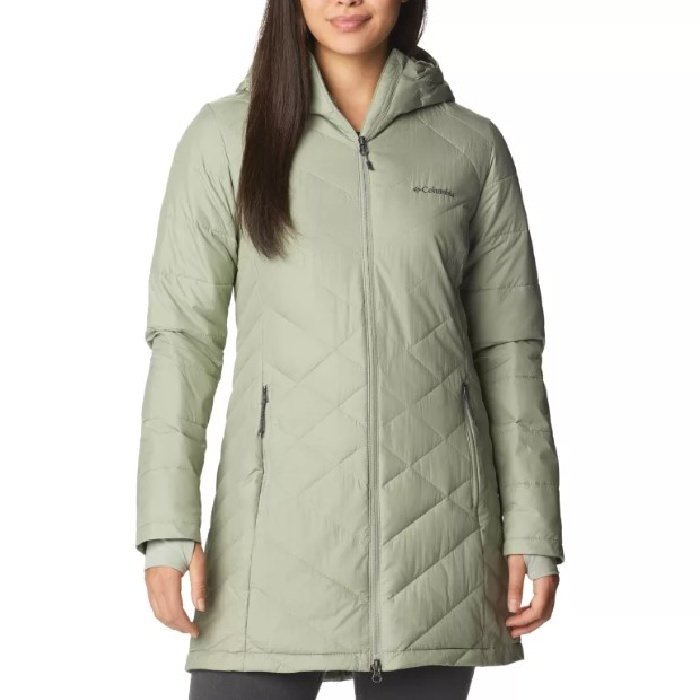
Columbia Heavenly Long
Best Budget Mild Winter Jacket
CleverHiker Rating: 4.2/5.0
Price: $160
Weight: 2 lb. 2 oz.
Length: 34 in.
Insulation: Synthetic down (polyester) & reflective lining
Pros
- Affordable
- Feminine cut
- Omni-heat technology
- Velvety soft lined hood
- Not bulky
- Lots of size options
Cons
- Not waterproof
- Less breathable than some
- Not as warm as some
- No hood adjustments
- Not great for layering
The Columbia Heavenly Long Hooded Jacket offers great value for those who need a reliable mild-winter or shoulder-season feminine cut coat that won’t break the bank.
It’s perfect for everyday use, whether you’re running errands or strolling through the city, though it’s not warm enough for temperatures below 30 if you aren’t keeping your heart rate a little above resting. Adding low-density base and mid-layers will help extend this coat into colder temperatures, but we wouldn’t rely on it if we were going to be without respite from the cold for a while.
Still, for the price, it’s hard to beat. The Columbia Heavenly Long Hooded Jacket strikes a sweet spot for anyone who needs a budget-friendly winter jacket without sacrificing style. Columbia uses their proprietary synthetic fill and Omni-Heat reflective lining, helping you retain warmth without the heft. While it won’t rival down for softness or warmth-to-weight ratio, it’s surprisingly cozy for cold days and offers a great fit with a sleek, clean design.
Though it’s not the most compressible option (synthetic insulation doesn’t pack down as small as down), it holds its own as a practical, everyday jacket for fall and spring days in cold climates but is perfect for anyone in more temperate zones.
The water-resistant shell protects against light moisture, and the comfy, well-fitting hood adds an extra layer of comfort. That said, we always felt a little clammy and cold in the shoulders when we tried this coat in temperatures below 35. If you’re heading into truly frigid conditions, you might want to layer up or opt for a more technical jacket with better insulation.
Product Comparison Table
| oSort | Product | Price | Weight | Insulation | Length | Warmth | Weather Resistance | Comfort & Functionality | Features | 0 |
REI Stormhenge 850 Down Hybrid Parka View at REI |
$299 | 1 lb. 10.5 oz. | 850-fill-power down / synthetic blend | 36.5 in. | 4.6 | 4.9 | 4.9 | 4.8 | 1 |
The North Face Arctic Parka View at REI View at North Face |
$350 | 2 lb. 13.5 oz. | 600 fill-power down | 35.25 in. | 4.8 | 4.8 | 4.8 | 4.8 | 2 |
Rab Deep Cover Down Parka View at REI View at Amazon |
$315 | 1 lb. 13.1 oz. | 700 fill-power down | 35.4 in. | 4.7 | 4.6 | 4.7 | 4.5 | 3 |
Outdoor Research Coze Down Parka View at REI View at Amazon |
$399 | 2 lb. 3 oz. | 95% 700+ fill-power down / 5% synthetic | 43 in. | 4.9 | 4.5 | 4.8 | 4.5 | 4 |
Fjallraven Nuuk Parka View at REI View at Amazon |
$500 | 3 lb. 13.1 oz. | Synthetic: 250g Supreme Microloft polyester | 33.8 in. | 4.7 | 4.8 | 4.7 | 4.9 | 5 |
The North Face Triple C Parka View at Backcountry View at The North Face |
$350 | n/a | 600 fill-power down | 46.4 in. | 4.9 | 4.6 | 4.7 | 4.3 | 6 |
Patagonia Down With It Parka View at REI View at Patagonia |
$350 | 2 lb. 5 oz. | 600 fill-power down | 39.3 in. | 4.7 | 4.1 | 4.7 | 4.5 | 7 |
REI Norseland Parka View at REI |
$230 | 2 lb. 2.2 oz. | 650 fill-power down & 120g synthetic blend | 36.5 in. | 4.8 | 4.4 | 4.6 | 4.2 | 8 |
L.L. Bean Ultrawarm 3/4 Length Down Parka View at LL Bean |
$250 | 2 lb. 4.6 oz. | 650 fill-power down | 37 in. | 4.5 | 4.6 | 4.0 | 3.9 | 9 |
Columbia Heavenly Long View at Amazon View at REI |
$160 | 2 lb. 2 oz. | Synthetic down (polyester) & reflective lining | 34 in. | 4.3 | 4.1 | 3.9 | 4.5 |
|---|
How We Test & Methodology
WARMTH
We assess a jacket’s warmth by wearing it in a range of temperatures, ensuring we experience its performance across different conditions. This approach helps us pinpoint the temperature range where the jacket performs best.
Additionally, we evaluate how it performs during different levels of exertion that are likely in these parkas i.e. stationary watching a hockey game, walking the dog, or running errands in town.
We tested passive heat loss by bringing the parkas from room temperature to the outside deck (38 degrees) and timed how long each parka took to get to ambient temperature.
We also stood outside in zero degrees and ~40 mph winds for 10 minutes and got a reading on the temperature inside the coat and noted any drafts or cold spots as well as anecdotal notes if/when we felt cold before the 10 minutes were up.
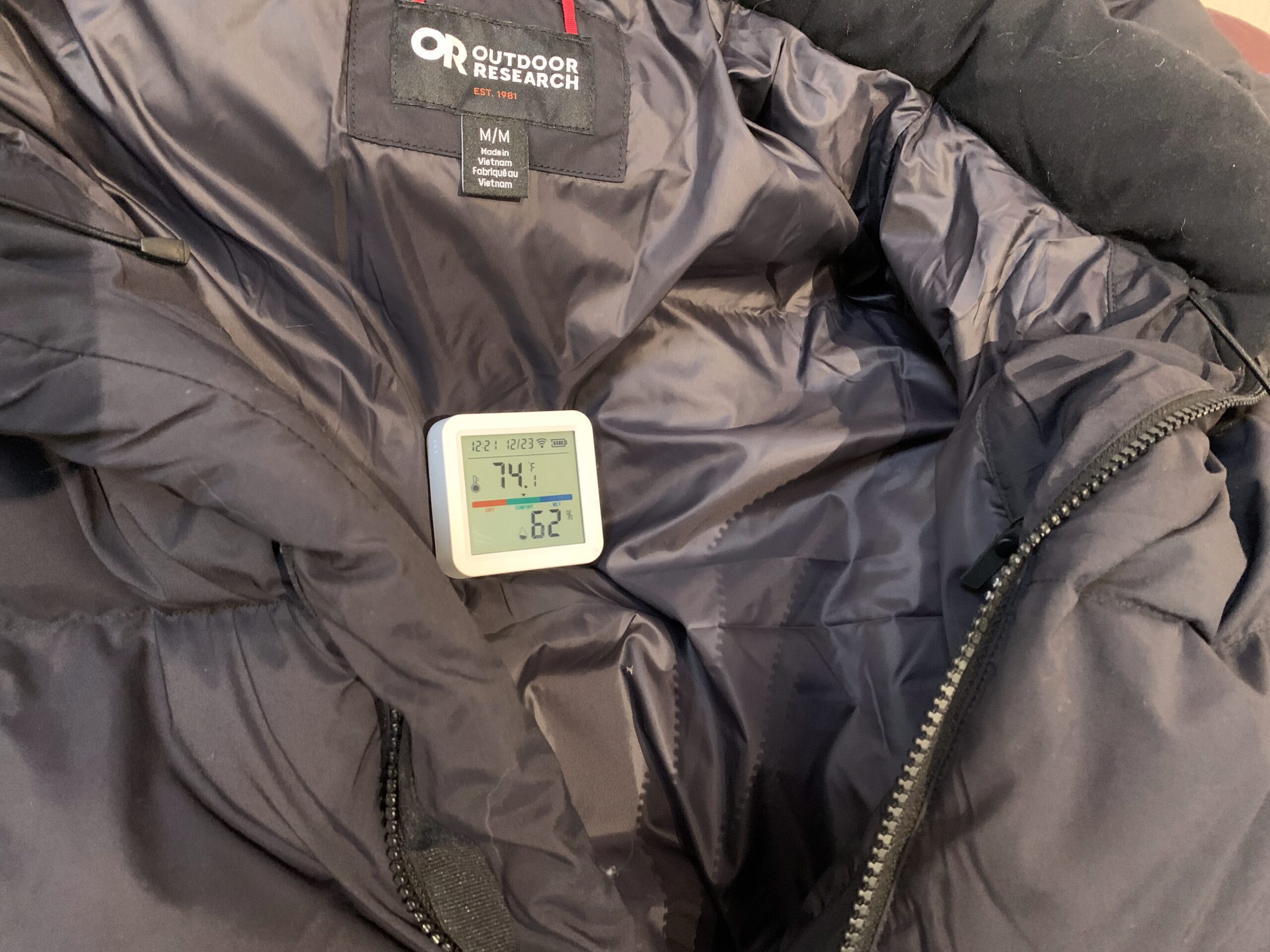
WEATHER RESISTANCE
When it comes to women’s winter parkas, we put them through a thorough series of tests to evaluate their ability to hold their ground in harsh weather.
From field tests at notoriously windy passes to snowstorm walks to a soak-through test, we test how long the jacket resists saturation through to the inner lining. We made a note of how the shell’s fabric beaded and shed moisture and blocked wind.
We also put the hood, collar, and adjustable features to the test, making sure they provide enough coverage and stay secure during blustery conditions.
On top of that, we check the cuffs and hem to ensure they effectively seal out drafts and prevent moisture from getting in. Our goal is to find out how well each jacket performs when faced with wind, rain, and snow in outdoor environments.
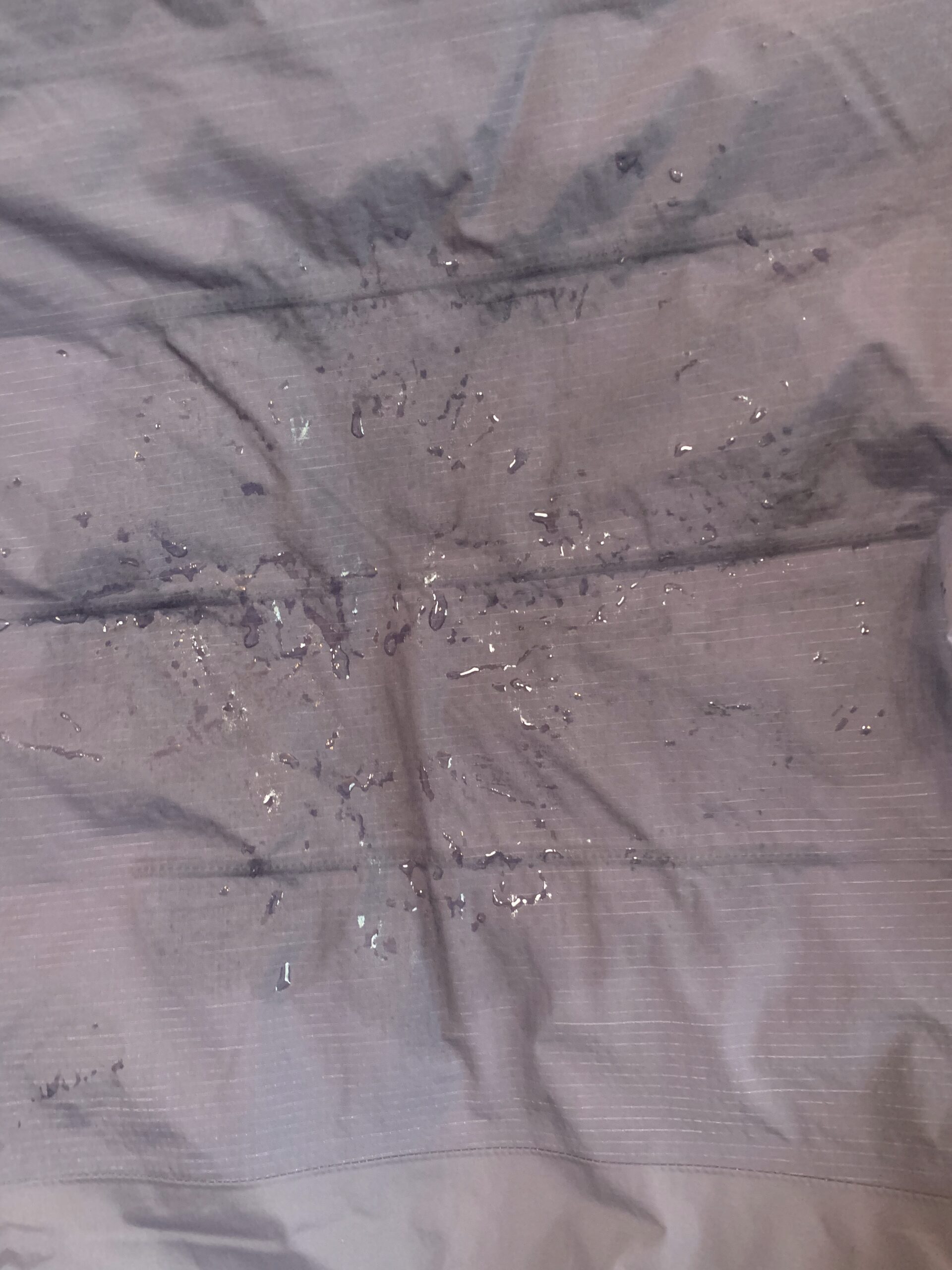
COMFORT & FUNCTIONALITY
Comfort is slightly subjective, so we try to evaluate objective differences in the parkas. Overall, we look at length, cut, and style. We see how these variables impact how the jacket wears, from heavy and bulky or cloud-like and flexible.
Functionality answers the question “Does the parka perform as the design intended?” Any function issues with zippers, pockets, hood wearability, buttons, and cinches are addressed here. We zip and button (or at least try to) all the coats with our biggest mittens to see how it works with other winter gear. We wear the hood in high winds to see how it protects our face and head.
Winter parkas aren’t technical gear, but we are trained to assess gear as if our life and enjoyment of wilderness adventures depended on it. So, although comfort and function are somewhat subjective metrics, we evaluate each jacket with a focus on delivering a high-quality experience where the coat adds to the outdoor enjoyment and doesn’t distract or detract from it.
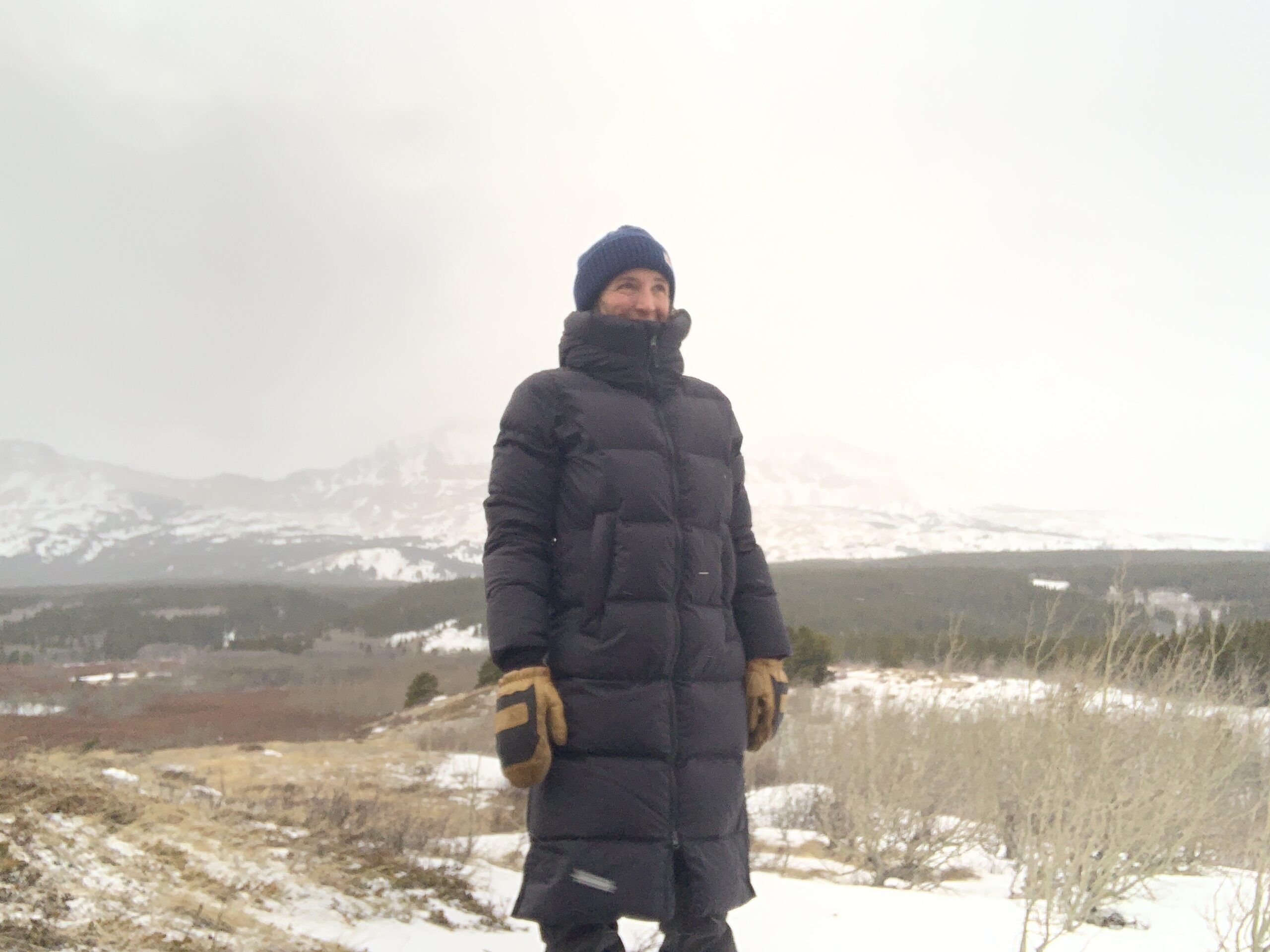
FEATURES
When evaluating the features of a winter parka, we look at how the design and small details work together to enhance the overall experience. This includes everything from pockets and zippers to cinches and hoods. Some jackets focus on simplicity for lightweight performance, while others go all-in with an array of functional elements. We test these features to see if they improve comfort and usability and how well they support the jacket’s intended purpose. The icing on the features cake is the jacket’s style and wearability, ensuring the whole design adds up to a high-performing piece of gear you’ll use all winter.
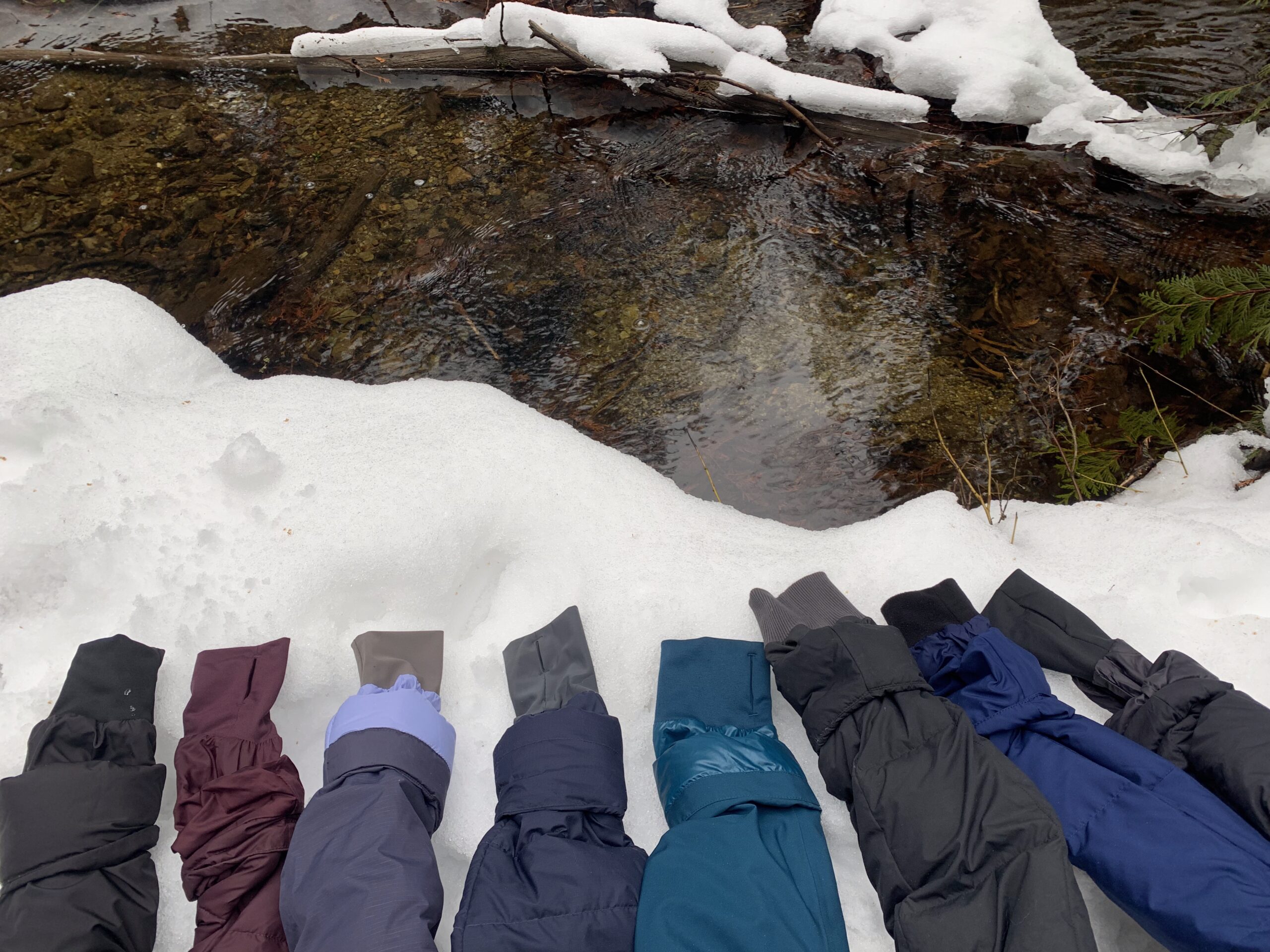
Why Trust CleverHiker
Gear Analyst Meghan Allsopp lives in NW Montana, and she’s been on the move testing winter parkas in conditions that even her dog didn’t want to romp around in. She stood outside in zero degrees and 40 mph winds to discern which coats were up for the onslaught of old man winter. She tracked grizzlies that passed through her backyard, explored the foothills of Banff National Park, and went on winter walks in Glacier National Park.
When Meghan isn’t writing for CleverHiker, she can be found snowboarding, hanging in a parka in the parking lot post adventure, cross-country skiing, and walking her Aussie/Lab mix in all conditions. She runs cold, has no interest in toeing the line of frostnip, and is an expert nit-picker because her gear is so heavily relied upon in remote wildernesses.
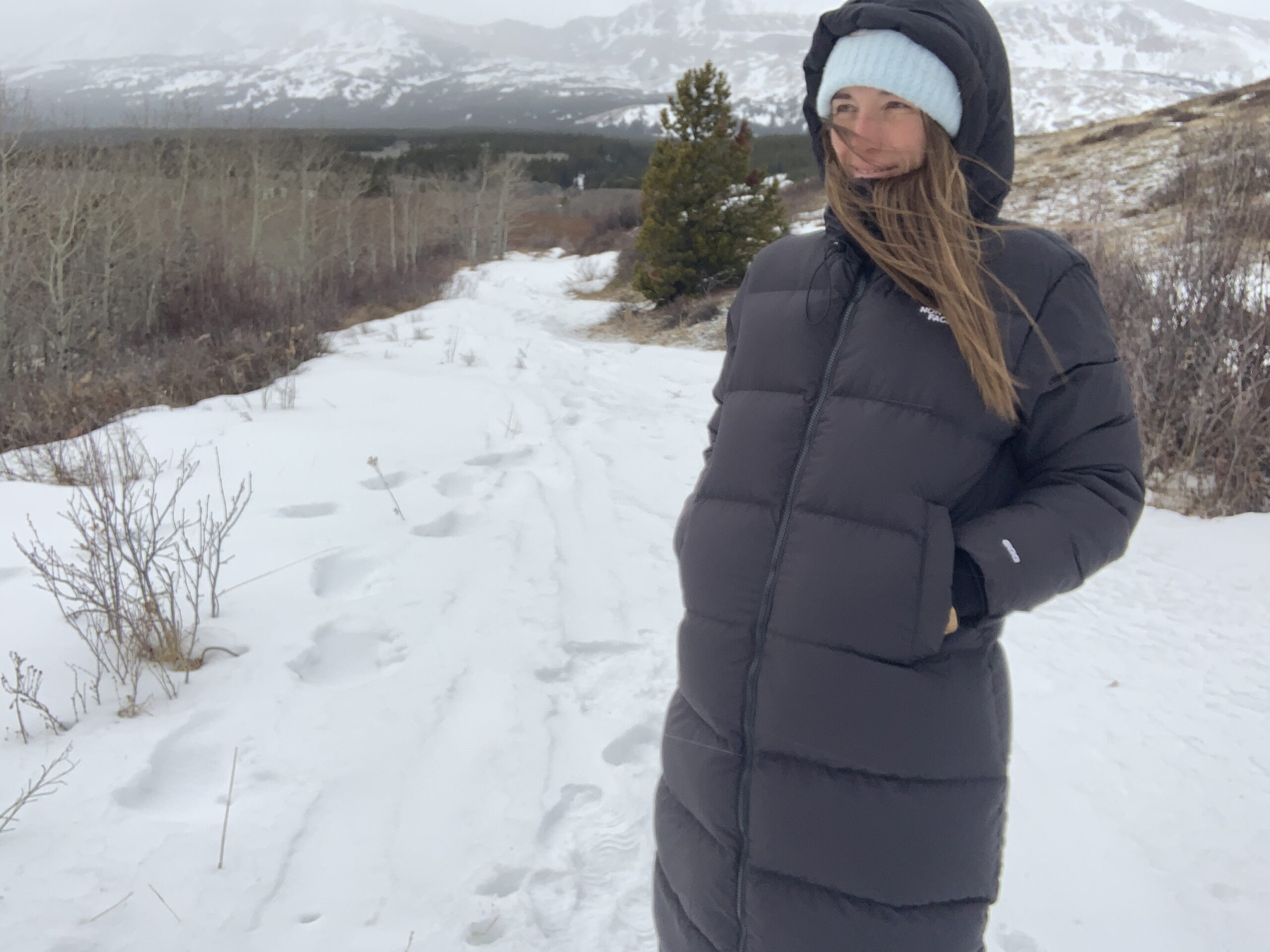
Analysis & Results
VALUE
Value at CleverHiker doesn’t mean low price. A highly valuable piece of outdoor apparel works in many conditions for many years and doesn’t break the bank. We look for a winter jacket that delivers reliable warmth and protection from the elements, doesn’t skimp on essential features, is designed with quality materials, and doesn’t have an outrageous price tag.
The two highest-value winter jackets are REI’s Stormhenge 850 Hybrid Parka and The North Face Arctic Parka. They both don’t just keep you warm but have waterproof shells and are fully seam-sealed so that the coat maintains function in mixed winter conditions. The Stormhenge is also body-mapped combining synthetic insulation where you want more breathability and down where you want more warmth. Topped with a waterproof shell that breathes well, this coat works great if you might be more active on adventures but still holds its own if you’re at a resting heart rate.
The North Face Arctic Parka is about a pound heavier than the Stormhenge and less compressible but has a higher insulation capacity for even colder, passive outings. It still is breathable, has a bomber hood, and removable faux fur for days when it is snowing sideways. These two are phenomenal bangs for your buck for ultimate all-weather winter coverage when you’re out and about.
Last but not least, Patagonia’s Down With It Parka is a beautifully made winter jacket. Its flattering stitching makes it street-worthy, and the thoughtful approach to sustainable outdoor apparel makes it feel even better to wear. We’ve trusted Patagonia’s quality construction and will probably be passing the coat to a grandkid someday.
WARMTH
We get it; it’s cold, and you want to be outside without feeling like you have to do jumping jacks to stay warm. Warmth is the ultimate measure of a good winter coat.
A winter jacket should have enough insulation that heat loss is gradual, and passively wearing it should register an internal temperature in the optimal comfort range of 68-72 degrees. This is the most important metric in this gear guide and so we examined how these winter coats performed in the field and the lab from 0-40 degrees. The Outdoor Research Coze Down (700-fill) and the North Face Triple C Down Parka (600-fill) are two top performers. They were nearly tied on our temperature, both taking over 3 hours to go from 71 degrees to ambient outdoor temperatures.
With roomy, high loft down-filled baffles, the air between the downy feathers did a great job of holding passive body warmth. The length is also key in protecting your body’s heat. Both of these parkas are calf-length, leaving only your face and ankles uncovered. Their insulated hoods also added to the warmth factor.
For shorter jackets with impressive insulating performances, The North Face Arctic and REI Norseland Down Parka both had a very gradual heat loss when we did our lab test and both took over two hours to go from 71 degrees to ambient temperature. Both are designed with a wind/storm zipper flap to prevent heat loss through the zipper.
The Rab Deep Cover performed unexpectedly well despite its tailored look and understated baffles. Its warmth power comes from 12 ounces of 700-fill-power down packed into the coat (which makes it a longer version of a technical performance puffy like Rab’s Neutrino Pro.
Unfortunately, because winter coats and parkas are more casually worn, fill-weight isn’t consistently offered by all the models we tested, so we can’t fairly compare this metric.
WEATHER RESISTANCE
Foul weather is part of a four-season life. Whether you’re planning a ski trip or just heading out for a dog walk, chances are you’re going to encounter some wintery weather.
All these puffy parkas have a tightly woven shell and, at the least, have a DWR water-resistant finish or treatment. But for the most part, puffy parkas aren’t designed to be worn in sustained rain. Their best weather resistance is that their shells shed dry snow relatively well. Things start getting cold and soggy for puffy’s when your body heat melts the snow on your coat and starts soaking through. As you probably know, if down gets wet, it loses its loft. No loft=no warmth.
Some models of puffy parkas solve this issue from the inside out. A few options on our list treat them down to increase weather resistance. Rab Deep Cover treats its European Goose down with a Nikwax Fluorocarbon-Free hydrophobic finish. LL Bean Ultrawarm uses DownTek PFC-Free™, a water-repellent down that claims to stay dry over 10x longer than untreated down for superior lofty warmth that’s still amazingly light. REI’s Stormhenge also claims its down is treated with a DWR treatment.
For ultimate protection from snow and rain (and sleet), the REI Stormhenge, The North Face Arctic, and Fjallraven Nuuk are all top performers in this metric.
We love the Stormhenge’s lightweight yet waterproof shell over its down-insulated core. Synthetic insulation in high-contact areas like the arms and hood is a great touch for places that are frequently exposed to moisture. This is a great option for cold and wet days on the ski or sledding hill.
The North Face Arctic uses DryVent technology. DryVent™ fabrics protect against the elements with a semipermeable polyurethane coating, and a multi-layer fabric that prevents water from penetrating while still allowing moisture vapor to escape, minimizing interior dampness. Additionally, the outer surface is treated with a durable water-repellent finish that causes water to bead up and roll off, enhancing its ability to shed moisture.
Fjallraven Nuuk is a three-layer, fully waterproof system that beads moisture excellently. The polyamide shell beads precipitation, but we noticed it does not slide off as easily as other smoother shells. Because of this, moisture does eventually let moisture penetrate the fabric. However, the three-layer system makes it so it never wetted through to the inner lining during our testing.
COMFORT & FUNCTIONALITY
A comfortable winter jacket can be subjective and depends on body type, whether you run cold or warm, and what you need your coat to do for you. The best coats for a full range of movement are the ones that balance adequate warmth without the bulk.
The Columbia Heavenly is super easy to wear and highly functional for mild winter outings.
The REI Stormhenge inner lining is so comfortable and slides easily over other layers, but it isn’t so long it restricts movement.
Rab Deep Cover is a longer version of a fitted backpacking style puffy. We often forgot we were analyzing this jacket because of how snug and comfortable it was.If the jacket is for passively standing out in the cold, the Outdoor Research Coze Down and The North Face Triple C take the cake for being super comfortable while winter is raging around you. These puffy parkas are like being wrapped up in a sleeping bag, down blankets, or an Arctic expedition suit. They offer superior coverage because they reach just about the top of your boots. This is your security binkie for any time you have to just stand or mosey through the cold.
FEATURES
Four stood out to us for their outstanding features: The REI Stormhenge 850 Hybrid Parka, REI Norseland, and Fjallraven Nuuk all have tasteful features that enhance their intended performance. The Stormhenge is designed to be worn while you’re moving or outside for extended periods. Its body-mapped down and synthetic insulation optimizes weight, compressibility, and warmth. It has so many features to keep you warm while you’re on the move: a sleeping-bag-style draft tube at the neck that stops heat from escaping, fully-sealed seams, gasket cuffs, 3 external pockets, and two internal drop pockets. The jacket features thoughtfully placed synthetic insulation in areas of high heat (hems, cuffs, hood, and side panels) because it insulates when wet and dries fast. REI thought of it all with this one.
REI strikes again with the Norseland Down Parka. It features a shearling hood that cinches, side thigh zips, and an insulated button storm exterior flap interior wind flaps on the two-way zipper. The old-school knit cuffs are also a nice retro feature. The end result is a sneaky warm coat that has some style.
When it comes to features, Fjallraven might beat the previous two. The Nuuk has 10 pockets, cuff velcro closures, removable faux fur ruff, adjustable fleece lined hood, hood and waist cinchers, and a double storm flap on the front zipper. Whew! The exterior fabric is a unique feature that makes it wearable for workwear, ripping groomers at the ski hill, and snowmobiling, but it still looks hip enough for around-town functionality. Expertly engineered, the Nuuk is built for cold weather functionality no matter the activity.
If a removable hood is a must-have feature, check out Patagonia’s Down With It, Rab’s Deep Cover, and LL Bean’s Ultrawarm.
How to Choose a Winter Jacket
IDENTIFY THE JACKET’S INTENDED USE
Before you buy a winter jacket, think about the climate where you live and what you’ll be using it for. Are you dealing with arctic temperatures and driving snow? Is this jacket meant for the urban life runaround, or will it be your go-to for nature walks and non-negotiable dog walks? Winter jackets spun off from technical jackets have a little more focus on performance, focusing on warmth and functionality over looks. More stylized jackets strike a balance between style and insulation. Like any gear, winter jackets have their sweet spots for different conditions and activities. Choosing the right one for your needs is key to staying active and comfortable in harsh winter conditions.
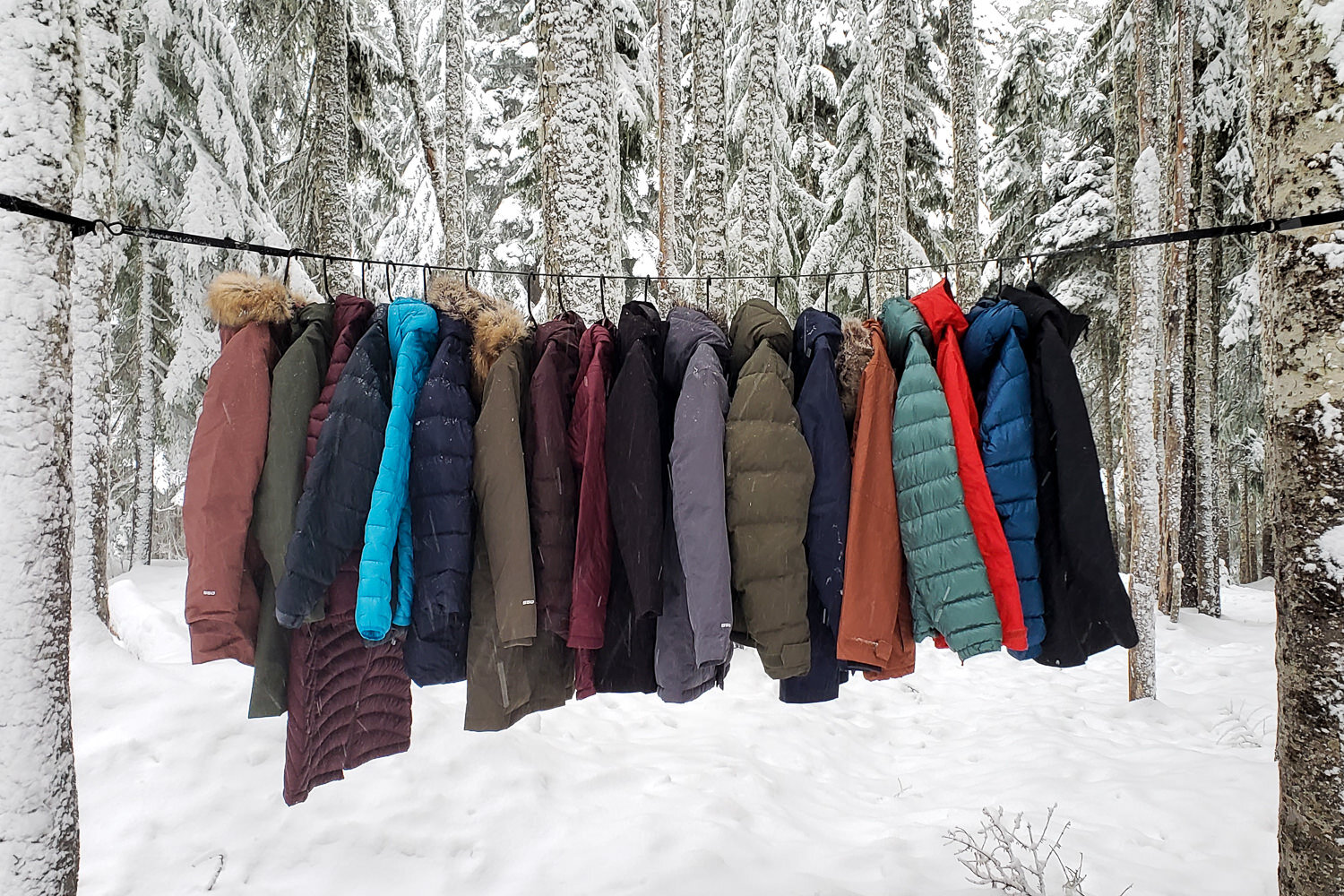
TYPES OF INSULATION
Down Insulation
Humans have long envied the power of feathers. Featherweight yet highly effective, they deliver unparalleled warmth for their weight. Down is best suited for dry snow and very cold environments. Fill is rated by its loft, or how many cubic inches one ounce of down fills. The higher the fill power, the more warmth the down delivers. Down works because the air in the lofty feathers gets caught and warmed by your body. That’s why if down gets soaked, the feathers glob up, and it quickly becomes ineffective. Some brands condition down with a hydrophobic treatment to help it keep its loft even when moisture penetrates the lining or shell. Our second favorite quality of down insulation is that it is highly compressible and packs down. If you’re planning on packing a parka in a suitcase or duffle, down might be best.
One of the issues with down insulation is that it is harvested from birds. Most outdoor companies ensure consumers that they’re trying to do it as ethically as possible Some companies have traceable down programs that ensure no live plucking, no force feeding, or buying from suppliers that don’t also farm their meat. Other companies use Allied, an ethically sourced down supplier. The North Face and Patagonia use recycled down in the parkas we tested.
Synthetic Insulation
You probably already know the biggest pro of synthetic insulation: it retains warmth even if it gets wet. This is ideal when your outings are far out and access to drying off is a long way away and far away. If you live in damp climates or you run hot, this might be your best bet. It gets tricky to compare down to synthetic because synthetic is measured in grams. Synthetics don’t pack down as well as down, but the technology on synthetic insulation keeps getting more efficient and packable.
Hybrid Options
Some winter coats opt to use the best of both worlds and mix the two. Designers construct hybrid jackets to have synthetic insulation in wet-prone spots like hoods, cuffs, and shoulder/collars. Down is usually sewn into areas that control your overall warmth and comfort, like your core. This is becoming more tested, and reviews are positive, so this style is likely only going to get more techy and more efficient.
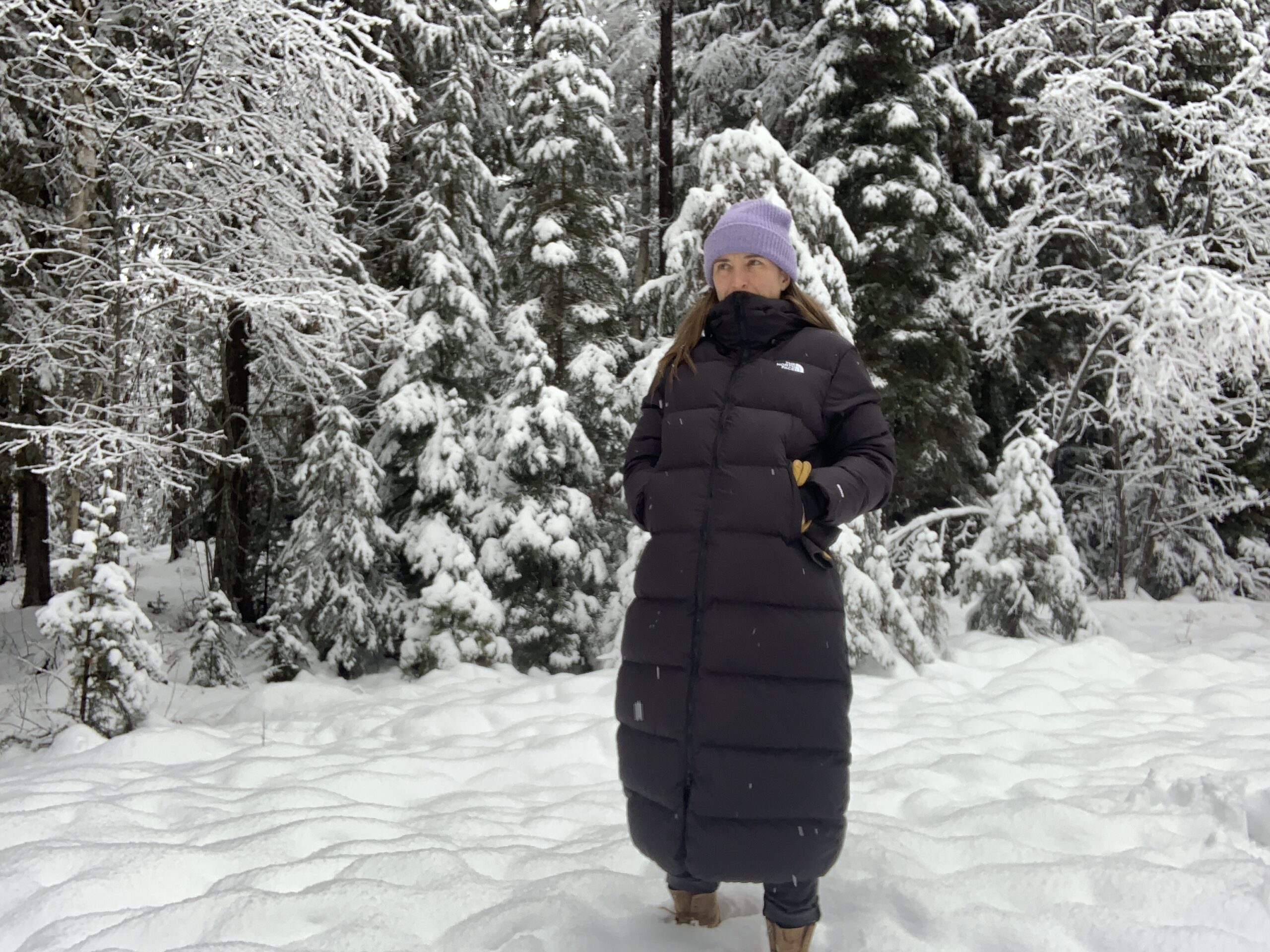
SHELL MATERIALS
Waterproof & Breathable Shells
If you’re looking for a winter coat that will keep you dry and warm in wet or snowy environments, waterproof and breathable shells are great. Most winter parkas have a nylon or polyester shell that protects down or synthetic insulation. They are usually treated with DWR (Durable Water Repellent) coatings to help bead and repel moisture. A DWR shell doesn’t make it waterproof, and it does wear off over time but it stretches how long it can repel moisture before wetting through. You should re-treat your coats with a tech wash when you notice the shell starting to soak through.
Combined with nylon or polyester that already has a low absorbency rate makes most winter parkas perform well for a lifestyle jacket. Materials like Gore-Tex or Polyamide are also waterproof fabrics that do a great job of shedding moisture, but those are often found in more technical coats that are meant to perform while being in rain/snow all day.
Softshells
Soft shells are usually stretchy and breathable. They’re great for layering under a fully waterproof hardshell if you’re going to be in the elements for a long stint. Softshells also work as an exterior layer for winter outings where you’ll be moving above a leisurely pace, or the temperatures are milder.
Hardshells
Hardshells don’t provide warmth through insulation. Instead, they shield wind, rain, and snow and are a must-have for the most severe and extended winter pursuits. They aren’t the most breathable, so we recommended pairing them with a few layers underneath to get the right warmth and breathability.
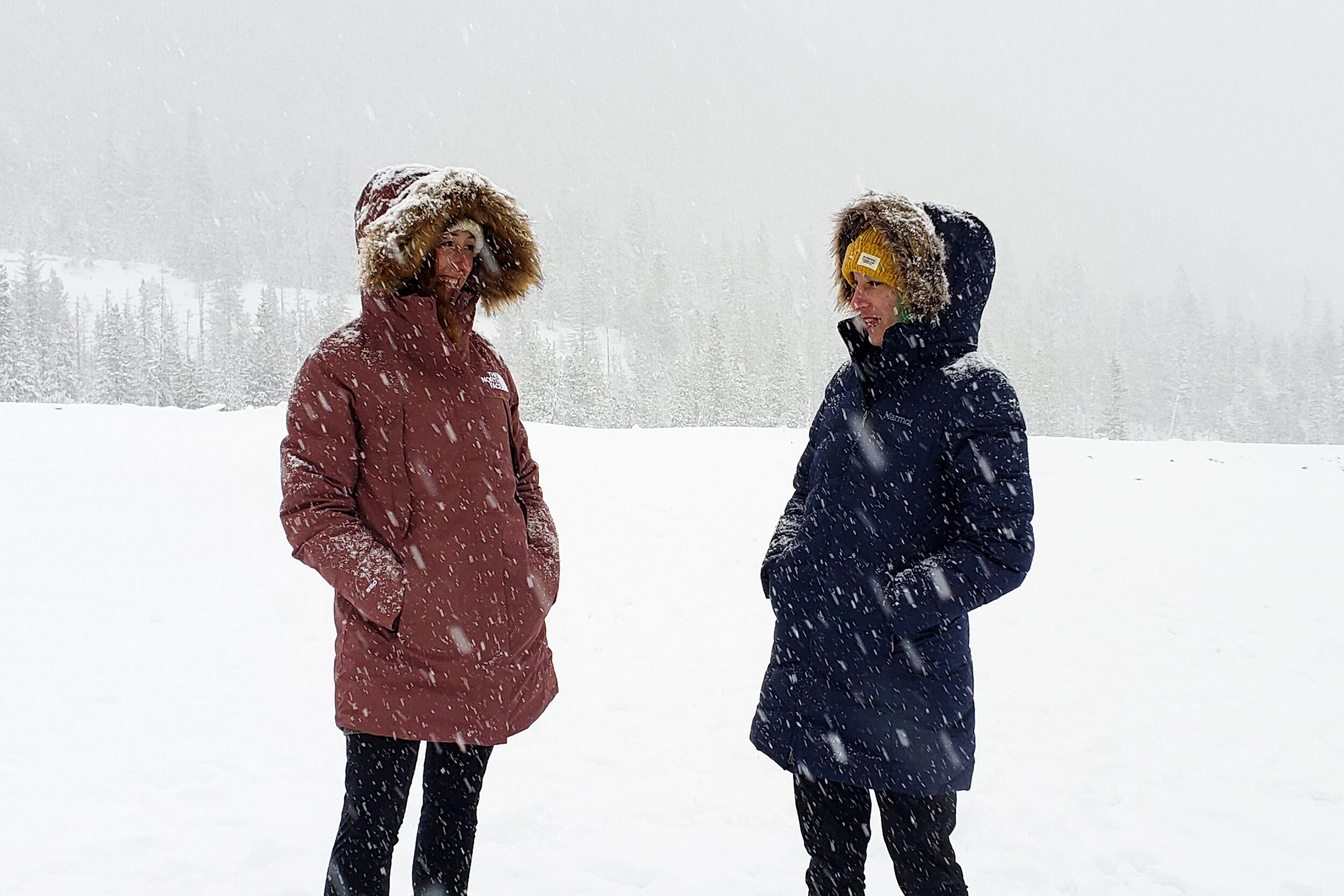
CONSIDER FEATURES FOR COMFORT & FUNCTIONALITY
Hood
A detachable hood adds versatility but will add weight and reduce packability. The detachable hoods we tested had a mix of zippers, buttons, and snaps to secure them to the collar. The best hoods aren’t so loose that they fill up like a sail in the wind and are not so tight that you can’t wear a hat underneath. Many winter coats have a removable faux-fur ruff, so you can tailor the coat depending on the use, occasion, and style. The fur further protects your face from all sides and reduces how much of your face is exposed. It can be uncomfortable to lose that much of your periphery but there’s a strong case for it if you’re heading into extreme environments.
Pockets
Most winter parkas have soft fleece-lined hand pockets. Some opt for fleece lining only on one side of the pocket. Other hand pockets were sewn in front of the insulation. Uninsulated pockets aren’t our favorite because they don’t keep your gadgets or your hands warm. Zipper pockets are preferred, especially if you’re playing in the snow or taking a tumble (sledding/skiing/snowboarding). We like drop pockets inside the jacket for mittens or hats. Snap button closures aren’t the easiest to close with gloves or mittens on, so we don’t use those pockets as often.
Cuffs & Hem Adjustments
Adjustable cuffs and draw cords on the waist and hems help seal out cold air and tailor the fit of the coat. Most longer parkas past the knees do not have an adjustable hem.
Collars
Some winter parkas have tall collars so you can easily tuck your chin in. This is ideal if you’re in really cold conditions, but it will feel like overkill in milder winters. Draft tubes on the collar add another barrier to the elements and help retain core body warmth. Our favorite collars were lined in fleece. Keep in mind that if you opt for a light-colored winter jacket, this area will discolor quickly from face oils, moisturizers, or sunscreen.
Zippers
A cheap zipper can be the downfall of an otherwise good jacket. We like two-way zippers because they can help increase ventilation or eliminate awkward bunches while sitting. Look for seam-sealed zippers or storm flaps to enhance protection against wind and moisture. Storm flaps are great for extra protection, but they often use snaps, and with a bulky jacket, snapping all of them can take a minute. Look for snaps that are attached in a way that won’t rip the shell. Some coats have side zippers that unzip for added mobility or comfort while sitting. This is great for anyone sitting outside on a bleacher.
Fit
Most winter parkas are designed to allow for layering. We recommend sizing up if you plan on layering a bunch or like the oversized look. Most companies do a good job of letting you know if it’s an active, tailored, or fitted design. If you have a broader upper body look for a relaxed fit or consider sizing up. Fellow long-arm ladies should look for cuffs with wrist gaskets. All our favorites fit a medium sweater underneath, but some will feel restrictive with bulkier layers.
Length
The longer the coat, the more warm and protected you will feel. Calf-length coats make you feel like a sasquatch that can be outside all winter. They do feel restrictive if you’re trying to move fast, take longer strides, or lunge for something. So, if you plan on power walking or being active in the coat, go for a jacket that hits above the knee. We also noticed that getting in and out of a car in a long coat takes some practice. It easily brushes against the body of the car and gets dirty.
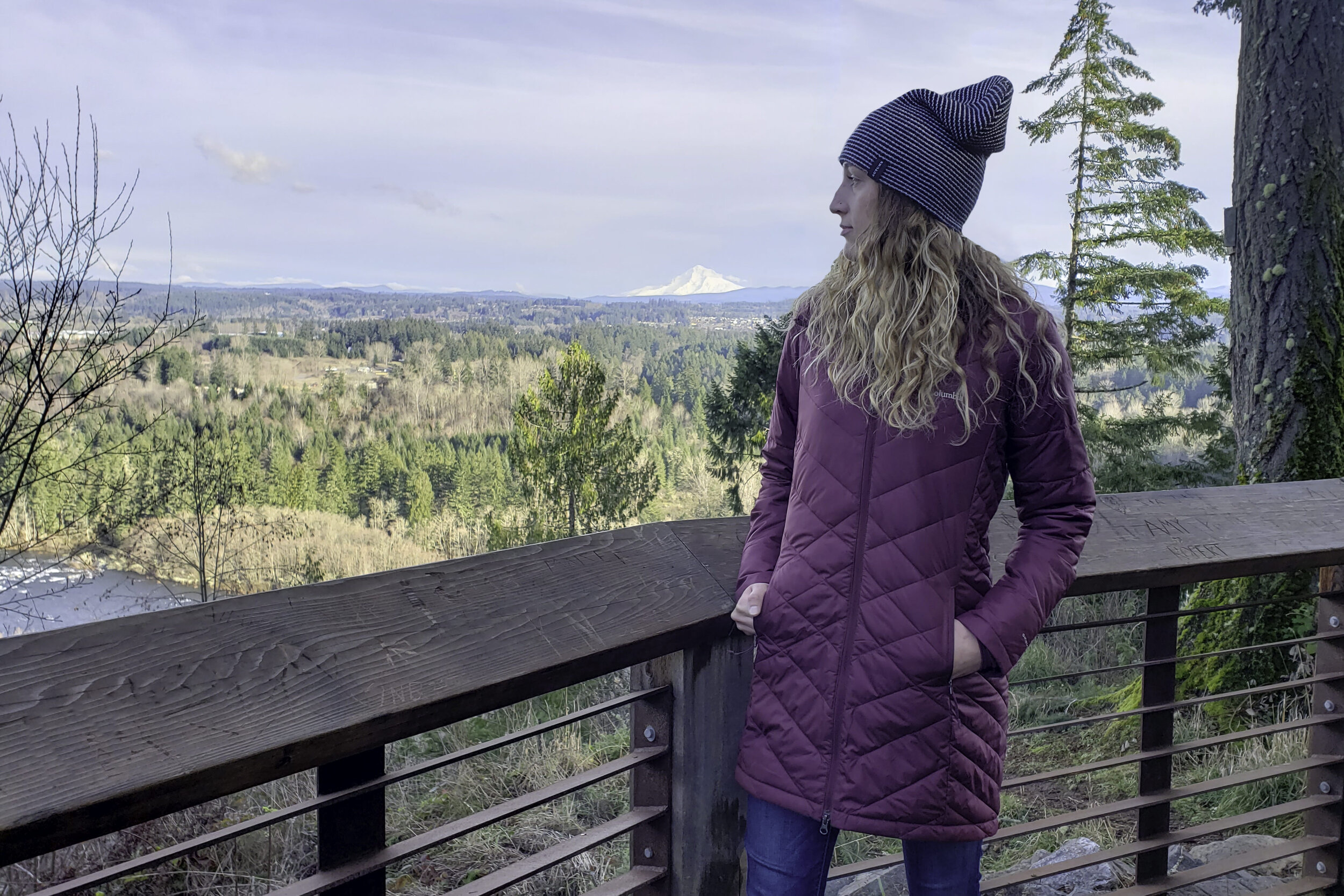
Conclusion
The Gear Analysts at CleverHiker nerd out on testing gear. Winter jackets can’t leave you hanging when inclement weather rolls so we hope this guide has given you the info you need to make the best decision for you.


